

What is a Cruise Ship?
A cruise ship is a luxury vessel that is used to take passengers on a pleasure voyage in a journey that is as much a part of the experience as the various destinations on the way.
In contrast to an ocean liner that transports passengers from one point on the globe to the other often across the oceans, a cruise ship or a cruise liner as it is known by most, takes the people on board to a round trip that is of varied duration, from a single day to possibly a week and culminates at the originating port.
This is a very refreshing mode of enjoyment and recreation, which relaxes the mind and replenishes energies to a great extent.
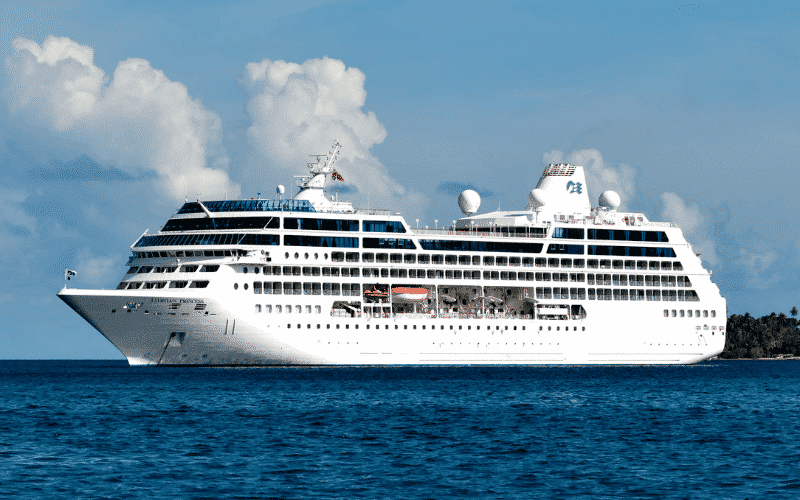
History of Cruise Ships
The present-day form of cruising can be traced back to the beginning of the twentieth century when transoceanic travelling was at its zenith.
The only mode of transport was the ships so the different companies that were in this business offered the best services to compete in the market.
These ocean liners with luxurious services offered what came to be known as line voyages. But because of the long journey, which at best would be no less than four days, there had to be huge storage for fuel and other necessities and that didn’t leave much room for luxuries.
With the advent of jet aeroplanes in the latter half of the last century, there was a shift in passenger preference and the long sea voyages were left for only the ardent sea fans.
Related Reading:
- How Are Cruise Ships Powered?
- How Do Cruise Ships Get Fresh Water?
The Advent of Cruise Ships
This situation was ideal for the launch of a cruise ship. It needed something strikingly different and exciting to bring back the interest of the people to sea voyages and this is where these trips gained popularity.
Considering the fact that the journey is relatively short with many stoppages at exotic locations, the ships are designed accordingly, thereby making more room and utilizing that space for an open design that exudes extravagance. It would be appropriate to liken a cruise ship to a floating hotel complete with a hospitality unit amongst other crew members.
Facilities on Cruise Ships
The facilities onboard these cruise liners include great dining services. Some liners offer open-air dining on the deck, whereas, there are others that have expensively designed dining halls with mouth-watering recipes to leave a long-lasting impression on the passengers.
In addition to this, there are casinos, fitness centres, spas, cinemas, and some ships even have a Broadway-like theatre. These cruise ships also boast swimming pools, hot tubs, lounges, libraries, gyms and clubs.
To put it in a nutshell, they pamper the passengers with the best of hospitality and services that can be imagined with some of the choicest natural views along the sea.
Over the last decade, cruising has become an integral part of the tourism industry contributing over $25 billion yearly to this booming sector. The major bulk of the business as expected comes from the North American and European regions but the other areas like the pan pacific are also catching up.
You might also like to read:
- Top 10 Largest Cruise Ships in 2021
- Top 10 Most Expensive Cruise Ships in 2021
- Engineering Department Onboard Cruise Ships – A Detailed Guide
- Titanic vs Modern Cruise Ship: How Ships Have Evolved
- Video: Why Are Cruise Ships White?
Related Articles
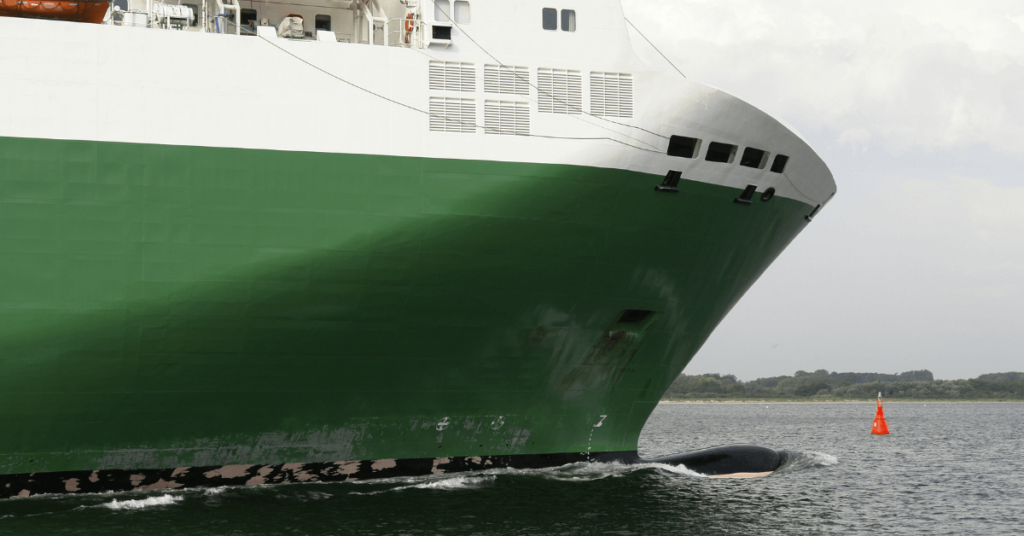
What are Hull Ferries?

New Jack-Up Vessel by Beluga- Hochtief
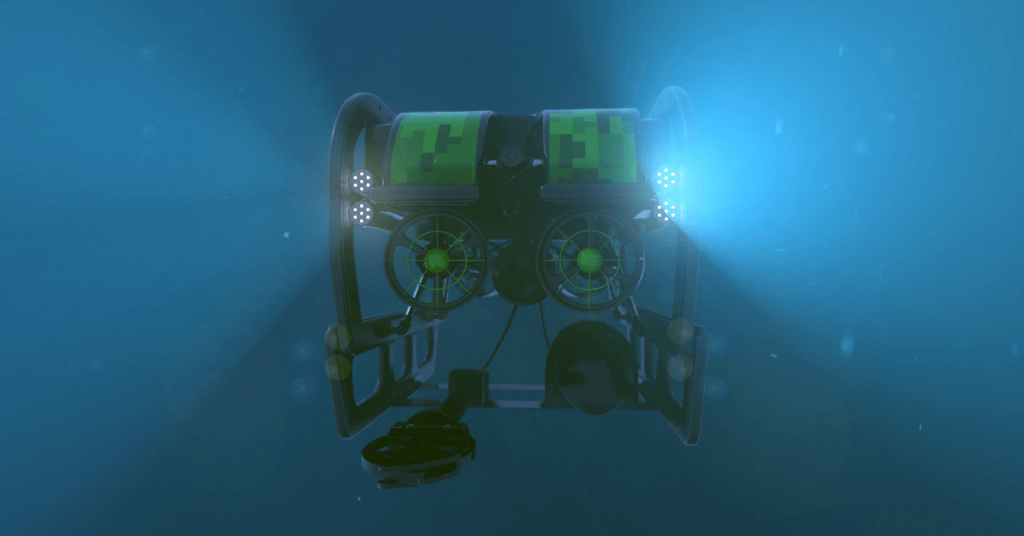
Everything You Ever Wanted to Know About Autonomous Underwater Vehicle (AUV)
Do you have info to share with us ? Suggest a correction
Disclaimer : The information contained in this website is for general information purposes only. While we endeavour to keep the information up to date and correct, we make no representations or warranties of any kind, express or implied, about the completeness, accuracy, reliability, suitability or availability with respect to the website or the information, products, services, or related graphics contained on the website for any purpose. Any reliance you place on such information is therefore strictly at your own risk.
In no event will we be liable for any loss or damage including without limitation, indirect or consequential loss or damage, or any loss or damage whatsoever arising from loss of data or profits arising out of, or in connection with, the use of this website.
About Author
Marine Insight News Network is a premier source for up-to-date, comprehensive, and insightful coverage of the maritime industry. Dedicated to offering the latest news, trends, and analyses in shipping, marine technology, regulations, and global maritime affairs, Marine Insight News Network prides itself on delivering accurate, engaging, and relevant information.
Daily Maritime News, Straight To Your Inbox
Sign Up To Get Daily Newsletters
Join over 60k+ people who read our daily newsletters
By subscribing, you agree to our Privacy Policy and may receive occasional deal communications; you can unsubscribe anytime.
BE THE FIRST TO COMMENT
Leave a reply.
Your email address will not be published. Required fields are marked *
Subscribe to Marine Insight Daily Newsletter
" * " indicates required fields
Marine Engineering
Marine Engine Air Compressor Marine Boiler Oily Water Separator Marine Electrical Ship Generator Ship Stabilizer
Nautical Science
Mooring Bridge Watchkeeping Ship Manoeuvring Nautical Charts Anchoring Nautical Equipment Shipboard Guidelines
Explore
Free Maritime eBooks Premium Maritime eBooks Marine Safety Financial Planning Marine Careers Maritime Law Ship Dry Dock
Shipping News Maritime Reports Videos Maritime Piracy Offshore Safety Of Life At Sea (SOLAS) MARPOL
WAIT! Did You Download 13 FREE Maritime eBooks?
Sign-up and download instantly!
We respect your privacy and take protecting it very seriously. No spam!
WAIT! Did You Download 12 FREE Maritime eBooks?
- Daily Crossword
- Word Puzzle
- Word Finder
- Word of the Day
- Synonym of the Day
- Word of the Year
- Language stories
- All featured
- Gender and sexuality
- All pop culture
- Writing hub
- Grammar essentials
- Commonly confused
- All writing tips
- Pop culture
- Writing tips
Advertisement
cruise ship
- a passenger ship built or used for pleasure cruises, usually taking passengers on an extended cruise with occasional calls in various places of interest.
Discover More
Word history and origins.
Origin of cruise ship 1
Compare Meanings
How does cruise ship compare to similar and commonly confused words? Explore the most common comparisons:
- ocean liner vs. cruise ship
Example Sentences
“That one case went through our community here, almost like a cruise ship,” Garry says.
Canada has banned cruise ships for another year, dealing the industry another blow after the Covid-19 pandemic shuttered most sailings for the past year.
Consider the image of the Diamond Princess cruise ship berthed in Yokohama, Japan.
I remember seeing the news about a virus in China and on cruise ships thinking, “Wow, that’s terrible,” and never once thinking it could come to Michigan.
As the virus hopscotched across the globe, cruise ships became early symbols of the pandemic.
Nerd Cruise By Adam Rogers, Wired What 800 Nerds on a Cruise Ship Taught Me About Life, the Universe, and Snorkeling.
He told the court he called the retired captain to see exactly where he lived so he knew when to sound the cruise ship horn.
More than 150 passengers on a California cruise ship came down with norovirus, continuing a trend that happens every year.
One hopes we will never have to repeat such a careless cruise ship disaster to find out.
And then you would get flown on a private jet up to Alaska and go on his cruise ship for the party.
Another meeting was held in late August to discuss the problem with members of the cruise ship industry.
The cruise ship industry companies have not as yet been placed under a permit system.
The tourists enjoyed the sights, but they ate aboard their ship, which was evidently somewhat like a Caribbean cruise ship.
You say the 'Lachesis' and they say 'Oh, yes, the cruise ship.'
Related Words
- luxury liner
- ocean liner
New to cruising? Here are all the terms you need to know

If you're new to cruising, you may feel like your fellow passengers are speaking in an insider, secret language, exchanging words and phrases that stump you. Fortunately, TPG can keep you from getting lost in translation with this handy glossary of cruise lingo. Take a peek and you'll know your berth from a beam in no time.
The ship and nautical terms
Aft: The rear (stern) area of the ship. When you select a cabin, you can pick one in that's aft, midship or forward.
Atrium: The splashy main entrance and lobby of the ship. If you sail Norwegian Cruise Line , you may know this spot as the Centrum.

Beam: Refers to the ship's width at its widest point. This is important since it's the measurement that will tell a captain if a vessel can transit tight spaces.
Bow: The very front of the ship.
Bridge: The bridge is usually on a high deck and forward. It's where the captain and officers navigate the ship. It's command central and usually off-limits to passengers with the exception of small cruise lines such as Windstar Cruises and Uncruise Adventures that offer specific times when you can stop by the bridge to ask the officer and his or her team questions.
Bulkhead: Partition walls in strategic places on the ship to prevent the spread of fire or flooding.
Dry dock: When a ship is at a shipyard or other location to be refurbished or have technical upgrades made.
Forward: Toward the front of the ship.
Funnel: The smokestack at the top of the ship. Most cruise lines paint their logo on the side of the funnel.
Galley: The ship's kitchen. Megaships like Royal Caribbean's Symphony of the Seas may have more than one galley.
Related: The ultimate guide to cruising with Royal Caribbean
Gangway: This is the removable ramp or steps that passengers use to board or disembark the ship.
Grand staircase: Many posh ships, such as Oceania's R-class ships, have a grand staircase in the atrium. It's a fabulous spot for photographs -- especially when you're all dressed up. You could use the shot on next year's holiday card!
Helm: The ship's wheel (or remote control navigation) and steering apparatus make up the helm.
Hull: The watertight body of a ship.
Keel: A bow-to-stern structural support that runs along the bottom of the ship. You'll often hear about a ship's keel-laying ceremony , which kicks off a major construction milestone.
Knot: Indicates the speed of a ship in nautical miles.
Lido deck: Old-school cruisers use this term to denote the pool deck.

Lifeboat: Every cruise ship carries smaller boats that can be used by passengers in case of emergency. Most often, these are separate vessels from the ship's tenders (see that term below).
M.S.: Means motor-sail, a type of ship. If you sail Windstar Cruises , you're likely already familiar with the term M.S.Y., which indicates motor-sail-yacht. Wind Surf, Wind Spirit and Wind Star are all motor-sail-yachts.
Midship: The middle section of the ship. If you're worried about getting seasick, book a cabin on a low deck at midship so you're close to the vessel's fulcrum point, where you'll feel less movement.
Mooring: A mooring is a physical structure to which a ship can be secured. Examples include piers, wharves, jetties, quays and anchor buoys.
Muster station: A designated location on the ship where each passenger must report for muster drill, a practice run in case of an actual at-sea emergency. Your muster station is printed on a map on the back of your cabin door and is listed on your cabin key card. The location could be in an interior bar or theater or on an open deck.
Panamax: A ship that's the right width to sail the Panama Canal. Anything larger than a Panamax vessel cannot transit the canal.
Port side: This refers to the left side of the ship as you face forward.
Porthole: An oval or round window. It's sealed shut so water can't get in, but it does provide light and a limited view to the world outside.
Promenade: The open-air walkways that usually span the entire length of both sides of the ship.
S.S.: Stands for "steam ship."
Skiff: These are shallow, flat-bottomed open boats used for expedition exploration. They are favored since you can execute wet landings on beaches and transit shallow bodies of water. They also help travelers get close to glaciers and rock formations. You may also hear people call them Zodiacs, but that's actually a brand name for this style of boat.

Stabilizers: Stabilizers, which sometimes look like wings on the sides of the ship, are retractable tools that can be deployed in rough seas. As the name infers, they stabilize the ship to provide a smoother sail.
Starboard: Refers to the right side of the ship as you face forward.
Stern: The rear end of the ship.
Tender: Small motorized boats that the cruise ship carries. They are deployed on port days and are used to ferry passengers from ship to shore.
Wake: If you've ever taken a cruise, you've probably photographed the ship's wake: It's the turbulence the ship causes in the water that creates a trail, not unlike an airplane's contrail.

Cabin intel
Balcony (veranda): Cruise ship cabins come in all types, including "balcony." It means the stateroom has a private balcony (shocker!) which is sometimes called a veranda.
Category: Ships can have several or many categories of cabins. This can mean inside, porthole, oceanview, balcony and suite varieties. And, one type of cabin can even have multiple categories. For example, inside cabins at the front of the ship, midship and aft can be in different cabin categories.
Related: The 5 best cabin locations on any cruise ship
Double occupancy: Most cruise fares are priced as double-occupancy, meaning two people sharing a cabin. If you book that cabin by yourself, you will often be charged a single supplement of up to 100% of the cruise fare. Alternatively, you can book a cabin meant for a solo traveler. Norwegian Cruise Line and Royal Caribbean both offer them, as do a lot of river cruise lines. Or, look for a low or waived "single supplement" fare.
Inside: Inside refers to a cabin that has no porthole, window or balcony.
Junior suite: Not a true suite, but a cabin that has a bit more room than a traditional oceanview or balcony. The bedroom and living space are usually separated by a curtain or other movable partition. (See "suite" for more information.)
Obstructed view: You'll see this note on some deck plans showing cabin locations. Obstructed view means you don't get a full line of sight through your cabin's window. You may be able to see part or all of a ship's tender that's stored outside your window. On Celebrity Edge and Apex, some rooms have views obstructed by part of the mechanism of the Magic Carpet.
Outside: When you book an "outside" cabin, you're getting one that includes a window.
Pullman (Murphy) bed: This type of bed pulls down from the ceiling or wall. It's a space-saving way to add another sleeping area to a cabin.
Spa cabin: Many cruise ships offer incredible spa facilities. To leverage those services, some ships dedicate an entire category of cabins to the spa. These cabins -- often located on the same deck as the spa -- often have upgrades such as rainfall showerheads in the bathroom and select perks packaged in the cruise fare, such as access to the spa's thermal suite.
Suite: A true suite means the bedroom and living area is separated by a permanent wall.
Related: What it takes to get concierge or lounge access on a cruise ship
Upper/lower berths: This can refer to bunk beds with the upper referring to the top bunk and the lower referring to the bottom bunk.
Virtual porthole/balcony: Some inside cabins have a virtual porthole or window, which is a screen that shows a live stream of what's going on outside. You'll find these on certain Royal Caribbean and Disney Cruise Line ships.

Cruise director: This is the person in charge of all the ship's social activities and entertainment. He or she is the MC for most events on board. Many cruise directors are highly trained musicians or entertainers.
Maitre d': This person holds court over an onboard restaurant and supervises the waitstaff and sommeliers. The maitre d' can assist you in making reservations and getting the specific table, waiter or waitress you prefer.
Porter: Shoreside, porters are the people who ferry your luggage from shore to ship, and vice versa.
Purser: The purser is usually found at the reception desk and is in charge of all onboard accounts and guest relations.
Sommelier: The terms sommelier and wine steward are interchangeable. This refers to the trained crewmembers who have an encyclopedic knowledge of wine. He or she can suggest the perfect wine to pair with your meals. Sommeliers also often host wine tastings on board and share their love of winemaking.
Steward: Each cabin is assigned a specific steward that tends to the room and its occupants throughout the cruise. Your steward will make sure your stateroom is set up correctly upon your arrival and will take care of daily cleaning and maintenance.
Dining terms
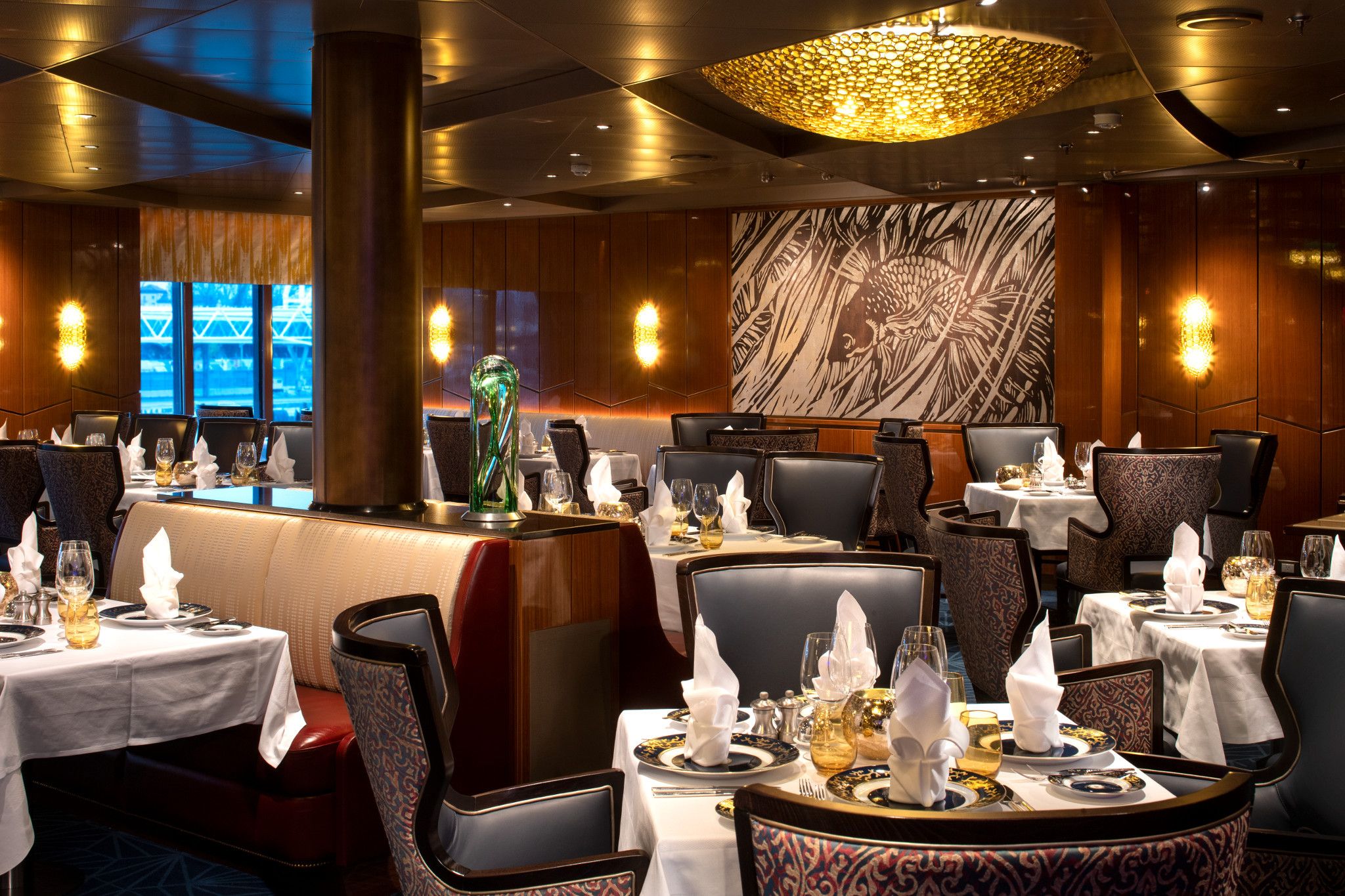
MDR: Stands for the Main Dining Room. The restaurant usually also has a specific name, such as the Sunrise Dining Room and Sunset Forward Dining Room on Carnival Sunshine.
Main seating/late seating: The Main Dining Room usually offers two sittings at dinnertime: main (also known as first or early seating) and a second, or late, seating.
Captain's or officers' table: Each evening in the Main Dining Room, the captain and other officers host tables. It's an honor to be invited to dine at one of these tables. Members of the cruise line's loyalty program are often invited and the cruise director may also recommend passengers for seating at one of these tables.
Related: A beginner's guide to cruise line loyalty programs
Open seating: Open seating means passengers can select where and when they want to eat, and with whom, instead of sticking to a strict early or late seating.
Specialty restaurant: Also known as alternative dining, specialty restaurants -- such as Cagney's Steakhouse aboard Norwegian Cruise Line ships — are smaller dining venues than the MDR. You'll usually pay a per person surcharge or order a la carte off the menu.
Related: 5 reasons you should splurge on cruise ship specialty restaurants
Dress codes
Cruise casual: Most cruise lines have basic dress codes. For daytime, passengers can usually wear casual clothing such as T-shirts, shorts, jeans and sundresses. While you can wear a swimsuit at the pool deck, throw on a cover-up when in other parts of the ship.
Cruise elegant/country club casual: On some cruise lines, they've gotten rid of the formal night but still have a slightly dressier standard for dinner. it's called cruise elegant or country club casual. Women generally wear dresses, blouses and skirts or slacks while men can wear collared shirts and slacks. Suitcoats aren't required but can be worn if desired.
Formal night: Usually once per seven-night cruise or twice on a two-week voyage, it's when the cruise line asks passengers to dress up for dinner. That usually means a black-tie affair, with tuxedos or dark suits for men and gowns or cocktail-style dresses for women.
Onboard events
Captain's cocktail party: Nearly ever cruise itinerary kicks off with a captain's cocktail party and/or dinner. The gathering gives the captain a chance to introduce himself or herself, the officers and pivotal crew members. At the cocktail party, it's customary to receive a free glass of Champagne and appetizers. If the cruise line still has formal night, the event is often paired with the first one of the cruise. So, passengers get dressed up to enjoy the festivities.
Friends of Bill W: A fathering of Alcoholics Anonymous members. Watch the daily cruise planner for meeting times and places.
Friends of Dorothy: A gathering of LGBTQ cruisers. Watch the daily cruise planner for meeting times and places.
Sail-away: Stay topside as the ship departs its embarkation port. The cruise director and band are usually at the pool deck entertaining guests and the drinks start flowing. The sail-away from some home ports, such as Miami and Venice, are particularly beautiful.
Berth: This word is used in two ways in the cruising world: Berth can be the pier at which your ship docks. Or, it can refer to the beds in a cabin. For example, if a cabin sleeps three, it has three berths.
Dock: These structures are built next to the water and provide space for ships to tie-up to load and unload passengers.
Home port: The ports from which a cruise ship embarks and disembarks. For example, Miami, Fort Lauderdale and Port Canaveral are all popular home ports in Florida where ships from many cruise lines depart on itineraries on a regular basis.
Pier: A pier is built with pillars or pilings over the water and is the place where ships moor.
Port of call: A ship's itinerary is made up of ports of call: The places the ship will stop so passengers can explore. Most cruises are a mix of sea days and days in port.
Shorex: This is an abbreviation for "shore excursion" and indicates the activities you can take part in on shore. You can purchase shore excursions directly from your cruise line or arrange them on your own.
Tender port: Some ports do not have facilities for cruise ships to dock. In those cases, they are called "tender ports" and that means you'll board the ship's tender (smaller boat) to transfer from ship to shore.
Transfers: Usually motorcoach transportation from the airport to the cruise terminal and vice versa at the beginning and end of your cruise. You can purchase these transfers from your cruise line.
Cruise-specific terms
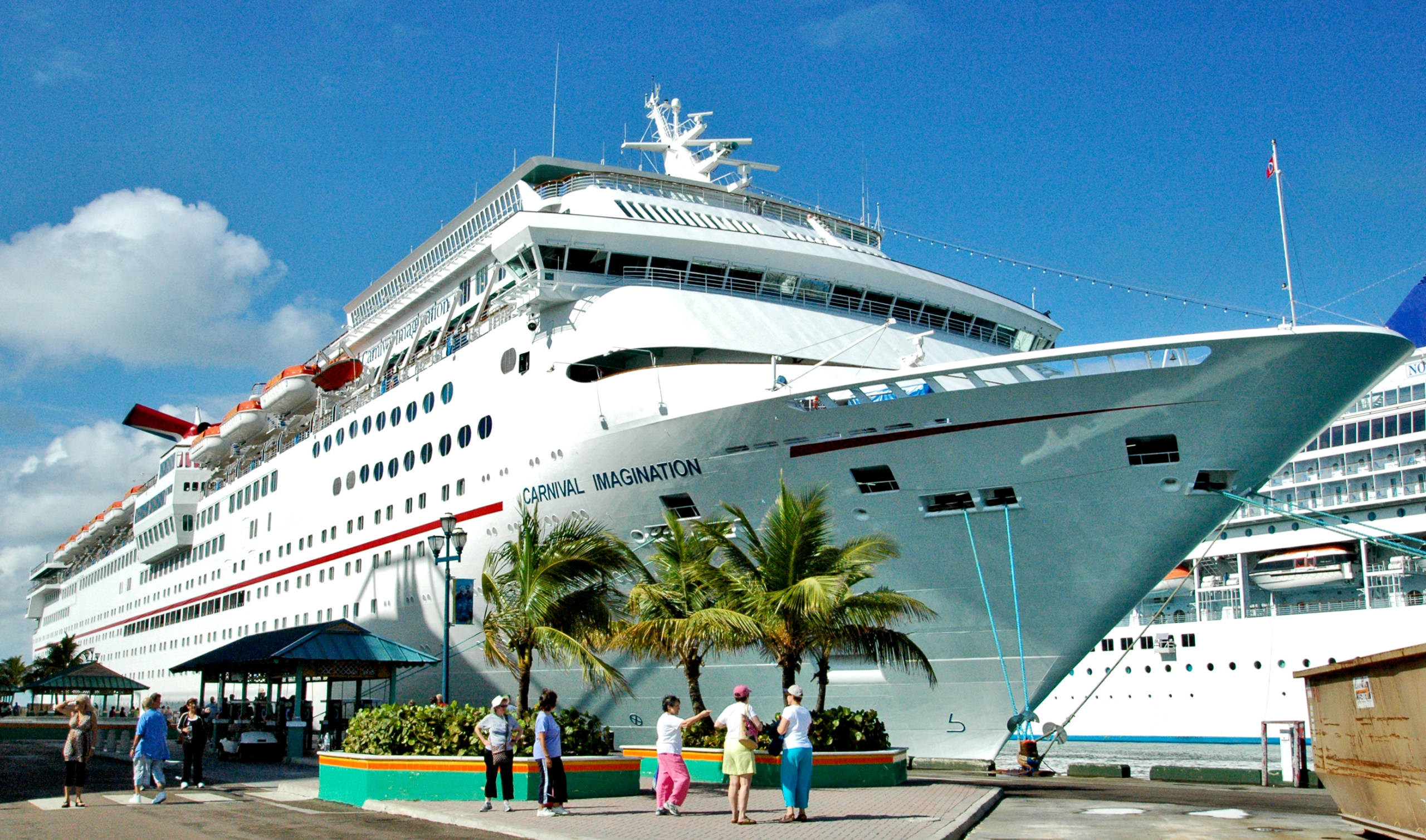
Air/sea: Cruise lines offer air/sea, or fly/cruise, packages that include both your flights to and from the ship as well as the cruise itinerary itself. Transfers between the airport and cruise ship are also usually included in the price.
All aboard: The time when all passengers need to be on board the ship before it sets sail. Ships don't wait for passengers in most circumstances so don't miss your all aboard time!
Back to back: This refers to two or more cruise itineraries that you book "back to back." It's a way to create a longer cruise vacation and see more ports of call. Most cruise lines offer a discount on the second itinerary in a back-to-back booking.
Charter: Cruise ships are the perfect venues for family reunions and corporate gatherings. You can charter an entire ship or just part of it. Sometimes you'll notice gaps in a cruise ship's schedule. Many times, it's because the ship has been chartered and there are no cabins available for anyone outside of that group.
Crossing: Crossings refer to sailings across oceans. Cunard's transatlantic crossings between Southampton, England, and New York City, are legendary.
Cruise contract: Before you book any voyages, carefully read the fine print in the cruise contract. It lists the various rules and regulations, including what recourse, if any, you have when things go wrong.
Cruise documents: About two weeks to 30 days before boarding your cruise ship, you'll receive your cruise documents. The paperwork includes your cruise ticket, airline tickets and hotel confirmations (if you booked them through the cruise line), pre-cruise and shore excursion information and luggage tags. Be sure to download this information from your online account. In most cases, you cannot board the ship without this paperwork in hand.
Cruisetour: This refers to a cruise and land tour package. Princess Cruises and Holland America Line both offer cruisetour packages to Alaska so you can see the best of the state by sea and land.
Related: The ultimate guide to Princess Cruises
Disembarkation: Departing the ship on the last day of the cruise.
Doc dancing: When your cruise documents arrive via mail, courier or your email inbox, many cruisers do the "doc dance" to show their excitement that their cruise will begin shortly.
Embarkation: Boarding the ship for the first time at check-in.
Godmother: Every ship has a godmother who is installed at a ceremony that coincides with the brand-new ship's inaugural voyage. This person, usually a woman, christens the ship and wishes it a lifetime of good luck and special sailings. Godmothers are usually celebrities, royalty or industry executives.
Inaugural voyage: This is the big celebration every brand-new ship has when it first sets sail. It's not necessarily the ship's very first sailing, but it's the one at which a big deal is made and where the godmother christens the ship.
Lanyard: Many cruisers like to stash their cruise card (key to their cabin and method to charge items to their onboard account) on a lanyard. A strap hangs around your neck with a plastic pouch at the bottom to keep your cruise card easily accessible.
Maiden voyage: This is a "first" for the ship. It can be a brand-new ship's very first voyage or a ship can make a "maiden call" on a port it has never visited before.
Repositioning cruise: Repo, or repositioning cruises, happen at the beginning and end of a regional cruising season. It's when the ship repositions from one home port to another. For example, a ship may spend the winter cruising out of Miami for Caribbean itineraries. In the spring, the ship repositions to Barcelona to sail out of that home port for Mediterranean voyages all summer long.
Sea day: A day at which the ship doesn't stop at a port of call. It stays at sea all day and night.
Segments: Longer voyages, like world cruises, are often broken up into shorter "segments." This makes it possible for cruisers to book just part of a longer itinerary.
Turnaround day: This is the day one cruise itinerary ends and another begins. Turnaround days are tough on the crew since they need to see every passenger off the ship safely, clean and prep the ship for the next batch of passengers, and welcome them on board. It's a very long and busy day for the crew.
Upgrade fairy: The upgrade fairy visits passengers on occasion. This is when the cruise line calls you (or your travel agent) to offer an upgrade. They are usually paid upgrades but the discounts make them very attractive.
Waitlist: Sometimes, an entire cruise itinerary or the cabin category you're interested in will sell out. If you want to be notified when cabins become available, ask to join the waitlist. If someone cancels the trip and a cabin opens up, the cruise line will contact travelers on the waitlist.
World cruise: Many cruise lines offer three- to four-month-long itineraries that span the entire globe.
Pricing and the bill
All-inclusive: You'll see the term "all-inclusive" used often in relation to cruise fares. It means "everything's included." However, read the terms since that's usually not quite true. Mainstream cruise lines such as Royal Caribbean and Norwegian Cruise Line generally include accommodations, all meals in the main dining room and buffet (as well as other free restaurants), nonalcoholic beverages and entertainment. Extras like wine and booze, spa treatments, specialty (for-fee) restaurants and shore excursions still cost extra.
Related: The ultimate guide to Norwegian Cruise Line
Future cruise credits (FCC): If you had to cancel or postpone a cruise due to coronavirus, you're probably very familiar with future cruise credits. These are vouchers with a dollar value that the cruise line gives out in certain circumstances, such as when an itinerary is canceled. Cruisers who receive an FCC can rebook on another ship and itinerary of their choosing.
Chit: The "chit" is the bill of sale you'll sign onboard cruise ships when you make a purchase. That could mean buying a drink at the bar, paying for a T-shirt in the boutique or signing up for a shore excursion. On truly all-inclusive lines like Regent Seven Seas Cruises or The Ritz-Carlton Yacht Club, you'll never sign a chit since nearly everything is included in your cruise fare.
Related: The ultimate guide to The Ritz-Carlton Yacht Collection
Guarantee (GTY) cabin: You'll sometimes see GTY fares. This means you can book the cabin category but not select the actual cabin number as you normally would. You are guaranteed a cabin in that category but, if it sells out, you will be upgraded to the next available cabin type. Read this for a complete explanation of cruise cabin guarantee fares and when you should -- or shouldn't -- book one.
Onboard (shipboard) account: At check-in, the ship will open an onboard account for you, and you'll provide a credit card. Charges will be added to this account throughout your cruise. At the end of the voyage, you'll receive an itemized bill. If you're fine with it, the total will be charged to the credit card on record.
Onboard credit: Cruisers love onboard credit (OBC), which is also known as shipboard credit. It's basically money that's deposited into your onboard account that you can spend during your cruise on things like alcohol (if drinks aren't included in your cruise fare), shore excursions and specialty restaurant fees. Cruise lines often lure passengers to book cruises with the promise of OBC. Travel agents also often reward clients by giving them a certain amount of onboard credit to thank them for booking a cruise through their agency.
- Dictionaries home
- American English
- Collocations
- German-English
- Grammar home
- Practical English Usage
- Learn & Practise Grammar (Beta)
- Word Lists home
- My Word Lists
- Recent additions
- Resources home
- Text Checker
Definition of cruise noun from the Oxford Advanced Learner's Dictionary
- I'd love to go on a round-the-world cruise.
- a luxury cruise ship
- Fire crews were called to the scene.
- He crews for a billionaire on his yacht.
- We're taking a cruise around the Mediterranean.
- I'd love to cruise down the Nile.
- package tour
- self-catering
- have/take (British English) a holiday/ (North American English) a vacation/a break/a day off/ (British English) a gap year
- go on/be on holiday/vacation/leave/honeymoon/safari/a trip/a tour/a cruise/a pilgrimage
- go backpacking/camping/hitchhiking/sightseeing
- plan a trip/a holiday/a vacation/your itinerary
- book accommodation/a hotel room/a flight/tickets
- have/make/cancel a reservation/ (especially British English) booking
- rent a villa/ (both British English) a holiday home/a holiday cottage
- (especially British English) hire/ (especially North American English) rent a car/bicycle/moped
- stay in a hotel/a bed and breakfast/a youth hostel/a villa/ (both British English) a holiday home/a caravan
- cost/charge $100 a/per night for a single/double/twin/standard/ (British English) en suite room
- check into/out of a hotel/a motel/your room
- pack/unpack your suitcase/bags
- call/order room service
- cancel/cut short a trip/holiday/vacation
- apply for/get/renew a/your passport
- take out/buy/get travel insurance
- catch/miss your plane/train/ferry/connecting flight
- fly (in)/travel in business/economy class
- make/have a brief/two-day/twelve-hour stopover/ (North American English also) layover in Hong Kong
- experience/cause/lead to delays
- check (in)/collect/get/lose (your) (especially British English) luggage/ (especially North American English) baggage
- be charged for/pay excess baggage
- board/get on/leave/get off the aircraft/plane/ship/ferry
- taxi down/leave/approach/hit/overshoot the runway
- experience/hit/encounter severe turbulence
- suffer from/recover from/get over your jet lag/travel sickness
- attract/draw/bring tourists/visitors
- encourage/promote/hurt tourism
- promote/develop ecotourism
- build/develop/visit a tourist/holiday/ (especially British English) seaside/beach/ski resort
- work for/be operated by a major hotel chain
- be served by/compete with low-cost/ (especially North American English) low-fare/budget airlines
- book something through/make a booking through/use a travel agent
- contact/check with your travel agent/tour operator
- book/be on/go on a package deal/holiday/tour
- buy/bring back (tacky/overpriced) souvenirs
- They met on a cruise.
- a cruise along the coast
- a pleasure cruise around the bay
- Modern cruise liners have every conceivable luxury on board.
- Now they could afford the world cruise they had promised themselves.
- She worked on a cruise ship as a croupier.
- They are going on a Mediterranean cruise.
- This year's cruise will visit the Norwegian fjords.
- We will be taking a cruise down the Nile.
- You can take a leisurely cruise on the lake.
- on a/the cruise
- cruise along
- cruise around
Want to learn more?
Find out which words work together and produce more natural-sounding English with the Oxford Collocations Dictionary app. Try it for free as part of the Oxford Advanced Learner’s Dictionary app.

- Food & Drink
- How to Plan
- Shore Excursions
- Onboard Activities
- What to Expect
Ocean Lingo: Glossary of Cruise Ship Terms
By Carnival Cruise Line
If you’re a newbie to cruising culture, take a few minutes to learn the cruise ship lingo. Knowing the language both on board and on shore will make you feel more at ease on your very first cruise . We’ve compiled a list of the most essential terms for you to be familiar with before you step on board.
From knowing the ins and outs of stateroom design to understanding cruise ship nautical terms, you’ll be ready to hit the waves with confidence.
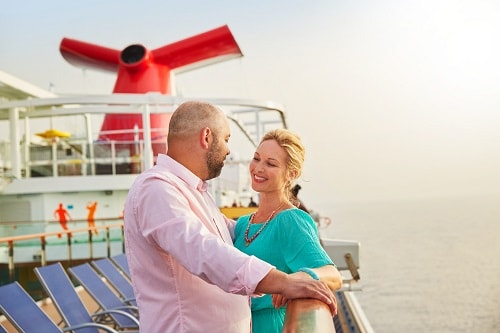
Planning Your Cruise
- Crossing: A voyage across the water – in other words, a cruise is a crossing. For example, if you take a cruise to Europe , you can depart from New York and cross to ports of call, including Northern Ireland .
- Departure port/embarkation port: Both of these terms refer to the port or location where your cruise begins and ends . Carnival has many departure ports in the United States. For example, you can cruise to the Western Caribbean from the departure port of Mobile, Alabama .
- Disembarkation: This is when you leave the ship at the end of your trip.
- Embarkation: It’s when you board your cruise ship at the beginning of your trip.
- Port of call: A port of call is a destination on your cruise and where you’ll likely be able to enjoy shore excursions. For example, if you take a cruise to Mexico , you can depart from one of three ports in California and visit multiple ports of call in one trip, including Cozumel , Costa Maya and Mahogany Bay .
- Shore excursion: A shore excursion is an activity off the ship at a port of call that you can purchase as part of your itinerary. For example, if you cruise to The Bahamas , you can take a shore excursion in Half Moon Cay. You may want to book the educational Stingray Adventure shore excursion there that allows you to interact with the sea creatures.
- Tender: Also called a lifeboat, a tender is a small boat that takes you from the ship to shore when the cruise ship anchors in a harbor.
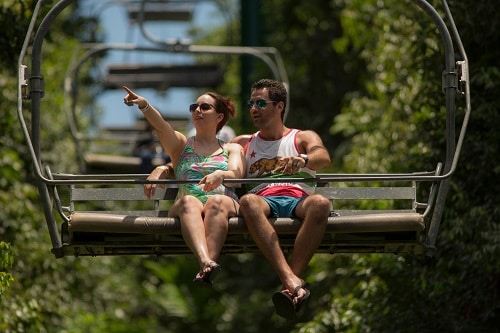
Stateroom Speak
Even before booking your cruise , you’ll want to know the types of staterooms that are available to ensure a comfortable trip. Whether you’re cruising solo or with a group, this list helps you choose the right stateroom for your needs.
- Balcony stateroom: This room has a small, personal, outdoor balcony. A balcony stateroom is recommended when taking a cruise to Alaska , for example, so you don’t miss any unexpected wildlife or glacier sightings.
- Interior stateroom: Located in less active spots on the ship, interior staterooms are comfortable for sleepers who prefer a quiet place to curl up after a day of fun and activities.
- Ocean view stateroom: An ocean view stateroom with a porthole or window lets you gaze out at ocean vistas and ports of calls.
- Specialty stateroom: This has a thematic setting that caters to families, couples or solo guests. Specialty staterooms include Cloud 9 Spa staterooms located next to the Cloud 9 Spa Family Harbor staterooms are next to the Family Harbor Lounge, a great escape when traveling with kids .
- Suite stateroom: Larger rooms that are ideal for family cruises . These suites give everyone in your group ample room to stretch out.
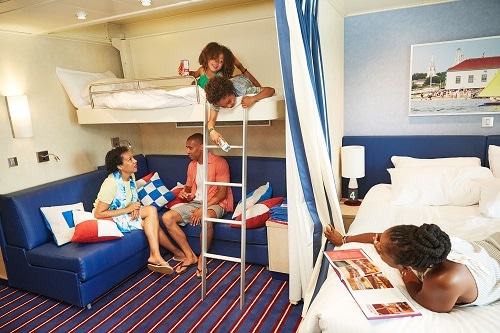
Cruise Ship Terminology
It pays to understand cruise ship terms and definitions so you don’t wander around too much during your vacation. Although, while on board, you’ll never be truly lost. You can find a deck plan of each vessel so you can get to know it before your trip in the comfort of your home. Until then, here’s a crash course in ship architecture.
- Bow: The bow is the front of the ship.
- Bridge: The bridge is the location from which the captain steers the ship.
- Galley: A galley is a ship’s kitchen. On a cruise ship, there are many galleys.
- Gangway: The gangway is the ramp or staircase that you’ll use to embark or disembark the ship.
- Helm: The helm is the area of the bridge on which the steering wheel is located and used by the crew only .
- Hull: The hull is the outside of the ship.
- Keel: The keel is the ship’s bottom center.
- Leeward: The side of the ship where you’ll feel most sheltered from wind is leeward.
- Lido: Lido is an often-used term because it’s the deck where you’ll find the outdoor pools .
- Midship: This is the middle of the ship.
- Port: The left side of the ship as it’s facing forward is called port. If you have a hard time remembering that, just keep in mind that “left” and “port” both have four letters.
- Starboard: The right side of the ship is starboard.
- Stern/aft: This is the rear part of a ship closest to the casual dining
- Upper deck: The upper deck is typically the area closest to the entertainment , fun and outdoor deck areas.
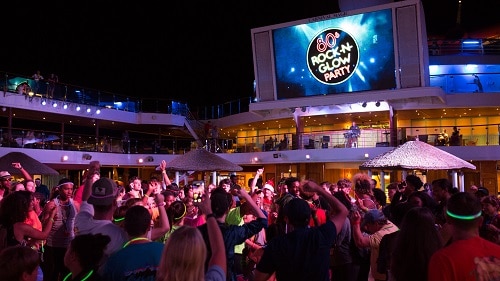
Dining Discussions
- Cruise casual: This is what you can wear most nights at dinner. For men, that includes slacks, khakis, jeans, dress shorts and collared sport shirts. Women wear casual dresses and skirts, pants, capri pants, dressy shorts and dressy jeans.
- Cruise elegant: This is the one or two nights on a cruise where it’s suggested you wear evening wear to dinner in the main dining room and some other restaurants. For men, that means dress slacks, dress shirts and sport coats (optional). For women, it’s cocktail dresses, fancier pant suits or skirts. In restaurants, such as the Steakhouse , you will be required to wear tasteful attire.
- Formal night: There are two formal, or elegant, nights on longer cruises. Elegant nights mean formal suits and ties or tuxedos for men and evening gowns for women. It’s not required to dress formally, yet formal attire is welcome.
- Main seating/late seating: This means there’s an assigned schedule and seating for passengers in the main dining rooms.
- Open seating: There’s no fixed schedule and no seating arrangements for dining with open seating.
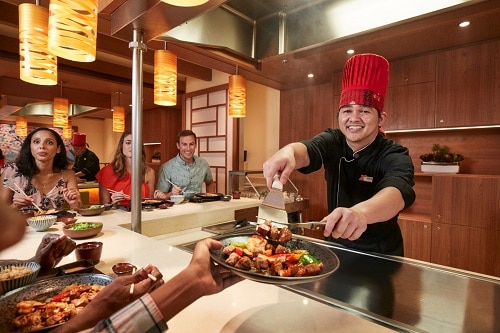
Crew Member Chatter
Who wouldn’t want to be a crew member on a cruise to Hawaii ? Here are some of the cheerful faces you’ll meet on board:
- Cabin steward: Crew member responsible for the housekeeping of your stateroom.
- Captain: Crew member in charge of the cruise ship, responsible for the crew and passenger safety.
- Cruise director: Crew member who organizes for the ship’s activities and entertainment and is often the emcee for onboard events.
- Maître d’: Crew member responsible for the dining room.
- Porter: Crew member on land to help you with your luggage curbside before you embark the ship.
- Purser: Crew member in charge of onboard billing and monetary transactions.
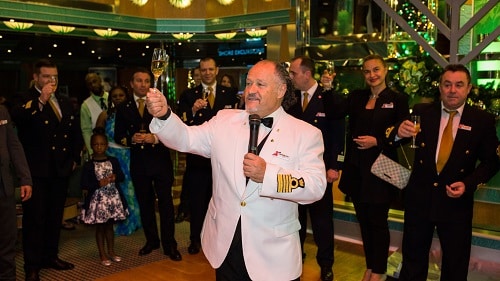
Nautical Lingo
Knowing nautical terms in the cruise ship world is important when you’re underway (which means moving through the ocean). You may hear the captain discussing knots with another crew member.
- Knot: A unit of speed at which ships travel, which is one nautical mile per hour.
- Mooring: A place where a ship is tied, such as the dock when in port.
- Wake: The trail of water created at the back (stern) of the ship as it moves forward in the water.
It’s perfectly fine if you forget your cruise-speak and just say “meet me at the room,” instead of stateroom, or “where’s customer service?” instead of asking to see the purser. On a Carnival cruise, you can just be yourself and learn at your leisure. Once you have your first cruise under your belt, you’ll be well on your way to becoming a seasoned cruiser with insider tips of your own.

Note: Onboard activities, shore excursions, and dining options may vary by ship and destination.
Related articles
What to expect.
https://www.carnival.com/cruise-ships.aspx

62 Terms About Cruises Every Cruise Traveler Needs to Know
Veteran cruisers are often loyal customers. It is not uncommon for some passengers to take multiple cruises a year. It can be a comfortable and affordable lifestyle. Other passengers are first time cruisers. They find themselves in a new world complete with its own terminology. Here are some of the terms and expressions to understand.
- Aft. It means to walk towards the rear section of the ship. It is often where the dining facilities are located. One line uses the expression, “Fun at the front, food at the rear.”
- Beaufort Scale. The standard measure for wind and storms. It is a 12-point scale, starting with calm and ending with hurricane force winds.
- Beam. The width of the ship at the widest point, usually somewhere in the middle.
- Below decks. These are the crew only sections, including where the crew lives and eats. These spaces are off limits to passengers.
- Boat. A small vessel. You should not call the cruise ship “the boat.” The old adage is: “A boat is what you get into when a ship is sinking.”
- Bow. The front end of the ship. It is narrower than the main body of the ship.
- Bridge. This is the command station for the ship, located forward with an unobstructed view of the ocean. This is where the ship is controlled and steered.
- Brig . The onboard jail. People don’t talk about it, but sometimes people need to be confined.
- Butler. If you have a more expensive cabin (suite) this is the person who looks after you. They can perform more services than a steward. The butler to passenger ratio is lower than the steward to passenger ratio.
- Cabins. If hotels have rooms, ships have cabins. It’s your personal space on board.
- Capacity. The number of passengers the ship could carry if every cabin was sold out.
- Captain. This is the person who is in charge of the entire operation. All departments report to them.
- Casual nights. You do not need to dress up in the dining room, but you should at least make an effort.
- Crew. The people who work on the ship. If expressed as a number, the total staff in all departments.
- Crossing. The traditional term for going from one side of the ocean to another. This is often associated with sailing from Europe to the US or vice versa.
- Deck Chairs. These are sun loungers for passenger use. They are usually open seating, meaning you cannot reserve one in advance.
- Decks. Ships do not have floors, they have decks. The surface beneath your feet on a ship is also called the deck.
- Disembarkation. The process for leaving the ship when you arrive in a port or your cruise is over.
- Dock. This is where the ship parks. It also means pier. The action of parking the ship is called docking.
- Draft. This is the number of feel the ship extends below the waterline. It is important because the channel into a harbor needs to be deep enough for the ship to comfortably sail in and out.
- Embarkation. This is the boarding process.
- Entertainment Director. The master of ceremonies for onboard shows.
- Fleet. The group of ships belonging to the same cruise line.
- Fore. Another name for the front end of the ship. It’s the beginning of the word forward, meaning you walk towards the front to find what you are looking for.
- Formal/Elegant/Gala night. Many ships have one or more dress up evenings. The cruise line brochures give you an idea how people are expected to dress. Different cruise lines define formal differently.
- Gangway. This is the ramp you use to enter or leave the ship in port.
- Horizon. The distance you can see, where the sky touches the sea. You should be able to see about 12 miles.
- Hull. This is the outside of the ship.
- Knots. How speed is measured while at sea. One knot is one nautical mile, which is 1.15 statute miles (how distance is measured on land in the USA).
- Laundry. Ships generally have several self-service laundromats with washers and dryers. These are free for passenger use.
- Lido deck. The outdoor deck space, usually where you find the swimming pools.
- Lifeboat drill. The mandatory safety briefing everyone must attend before the ship sails. It’s similar to the safety announcement on airplanes.
- Line. Although the ships might be owned by a company listed on the stock exchange, the company’s ships fly under the same flag, representing the cruise line. Ships are owned by lines.
- Maître ‘d. This is the person running the dining room. If you want to change tables, this is the person to see.
- Noontime announcement. Traditionally the captain announces several facts over the PA system at noontime. This includes the ship’s location, distance travelled and weather conditions.
- Port. The left-hand side of the ship. The term also can mean a destination, a city you are visiting.
- Promenade deck. This deck circles the ship, allowing passengers to walk in a complete loop. Once upon a time, walking or strolling was called promenading. Today, you will find joggers doing their laps.
- Open seating. Also called terms like Freedom Seating. This means you have flexibility when you can turn up for meals and who you want to sit with for the meal.
- Port taxes. Parking the ship is not free. The ports you visit charge a fee for the ship to tie up and discharge passengers.
- Program. This is the daily agenda of activities. It is often left in print form in your stateroom at night.
- Pub Quizzes. Quizzes are an integral part of entertainment at sea. Passengers show up, form teams and try to answer a list of questions together. It’s a great way to make friends because everyone knows something, but no one knows everything.
- Purser. Ships have multiple sections. The big three are hotel, food and engine. The purser is the hotel manager, running that part of the operation. Food would also fit within their responsibility.
- Resetting clocks. If you are crossing from one time zone to another, you set the clock forward or backward. This happens at nighttime when you lose an hour, meaning you get an extra hour’s sleep.
- Seatings. Traditionally, seating in the dining room was assigned. You chose either early or late seating, also called first and second seating. The timing is often 6:00 PM and 8:30 PM. You have an assigned table location, designated by a card in your cabin you bring with you to the first dinner.
- Section Captain. The main dining room is divided into sections. The Maître d’ oversees the entire operation. Their next level of supervision is the table or section captains overseeing a segment of the dining room. They keep the service running smoothly.
- Security. The ship has its own discrete guard network. There are sections of the ship off limits to passengers. They check you in and out when you leave the ship to go into port.
- Ship. The preferred term for cruise ships. A boat is a smaller vessel.
- Shipboard account. Cash is not used to pay for things during your cruise. Your cabin keycard works like a charge card, adding to your tally of spending while onboard. You settle up before leaving the ship. They already have your credit card information on file.
- Shuttles. These are the buses that take you into town or beyond the restricted area of the port if you have not purchased a tour package. Shuttle buses are usually free.
- Specialty restaurants. Traditionally, meals in the main dining room are included in your cruise fare. Ships have other, often fancier restaurants you pay a surcharge to use.
- Staff Captain. This is the #2 person in charge, directly below the captain in authority.
- Starboard. The right-hand side of the ship.
- Stern. The rear section of the ship.
- Stateroom . Another name for a cabin. Sizes are usually standardized, until you get up to suites.
- Steward. The term for the person who looks after you and your cabin. They make the bed, change the towels and are ready to help with simple requests.
- Suites. The larger, more expensive cabins.
- Tender. Sometimes, ships are too large to dock in port. The ship anchors out a short distance away and smaller ships bring the passengers into port and back again. These boats, called tenders, are often carried by cruise ships. The process of taking a smaller boat out and back is called tendering.
- Tips. Gratuities. It was once traditional to distribute them to the cabin and dining room personnel who looked after you during the trip. Today, they are often automatically added to your shipboard account. It has been said the term TIPS was originally an acronym for “To Insure Proper Service.”
- Tonnage. The method to calculate the size of a ship. It refers to internal volume. The standard definition is 100 cubic feet equals one ton.
- Tour office. This is the desk where you book land tours and shore packages if you have not done so in advance.
- Voyage. An upscale term to use in place of cruise. You are not simply taking a cruise; you are on a voyage.
- Waterline. This is the line where the color of the hull is painted differently. One color is below the water, the other color is above the water.
Now you know the language and can engage with your fellow passengers like a cruise ship veteran!
Cover photo ©Dennis Cox/WorldViews: Trio Carnival ships in Cozumel
Browse Cruise Ships and Cruise Lines
Ed. Notes: CruiseCompete and its member travel advisors provide many curated cruise and land deals, offers and amenities on over 50 cruise lines with over 500 cruise ships sailing all around the world.
Sea Tales 2023 Family Cruise Travel Planner (flippingbook.com)
Shore Excursions – Ports, Day & Weekend Trips
Leave a Comment Cancel reply

All Things Cruise is dedicated to the joy of travel. Specializing in ocean, river, ultra-luxury, small ship and expedition cruises.
We would love to have you subscribe for travel updates, news and great offers directly from the cruise lines!

- More from M-W
- To save this word, you'll need to log in. Log In
Definition of cruise
(Entry 1 of 2)
intransitive verb
transitive verb
Definition of cruise (Entry 2 of 2)
- gad (about)
- galavant
- kick around
- knock (about)
Examples of cruise in a Sentence
These examples are programmatically compiled from various online sources to illustrate current usage of the word 'cruise.' Any opinions expressed in the examples do not represent those of Merriam-Webster or its editors. Send us feedback about these examples.
Word History
Dutch kruisen to make a cross, cruise, from Middle Dutch crucen , from crūce cross, from Latin cruc-, crux
1651, in the meaning defined at intransitive sense 1
1696, in the meaning defined above

Phrases Containing cruise
- adaptive cruise control
- booze cruise
- cruise control
- cruise liner
- cruise missile
- cruise ship
- radar cruise control
Dictionary Entries Near cruise
Cite this entry.
“Cruise.” Merriam-Webster.com Dictionary , Merriam-Webster, https://www.merriam-webster.com/dictionary/cruise. Accessed 17 May. 2024.
Kids Definition
Kids definition of cruise.
from Dutch kruisen "to cruise, move crosswise," from early Dutch crūce "cross," from Latin crux "cross" — related to cross , crucial
More from Merriam-Webster on cruise
Nglish: Translation of cruise for Spanish Speakers
Britannica English: Translation of cruise for Arabic Speakers
Subscribe to America's largest dictionary and get thousands more definitions and advanced search—ad free!

Can you solve 4 words at once?
Word of the day.
See Definitions and Examples »
Get Word of the Day daily email!
Popular in Grammar & Usage
More commonly misspelled words, your vs. you're: how to use them correctly, every letter is silent, sometimes: a-z list of examples, more commonly mispronounced words, how to use em dashes (—), en dashes (–) , and hyphens (-), popular in wordplay, the words of the week - may 17, birds say the darndest things, a great big list of bread words, 10 scrabble words without any vowels, 12 more bird names that sound like insults (and sometimes are), games & quizzes.

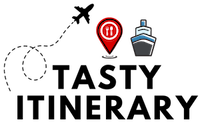
Understanding Cruise Words and Lingo To Chat Like a Cruiser
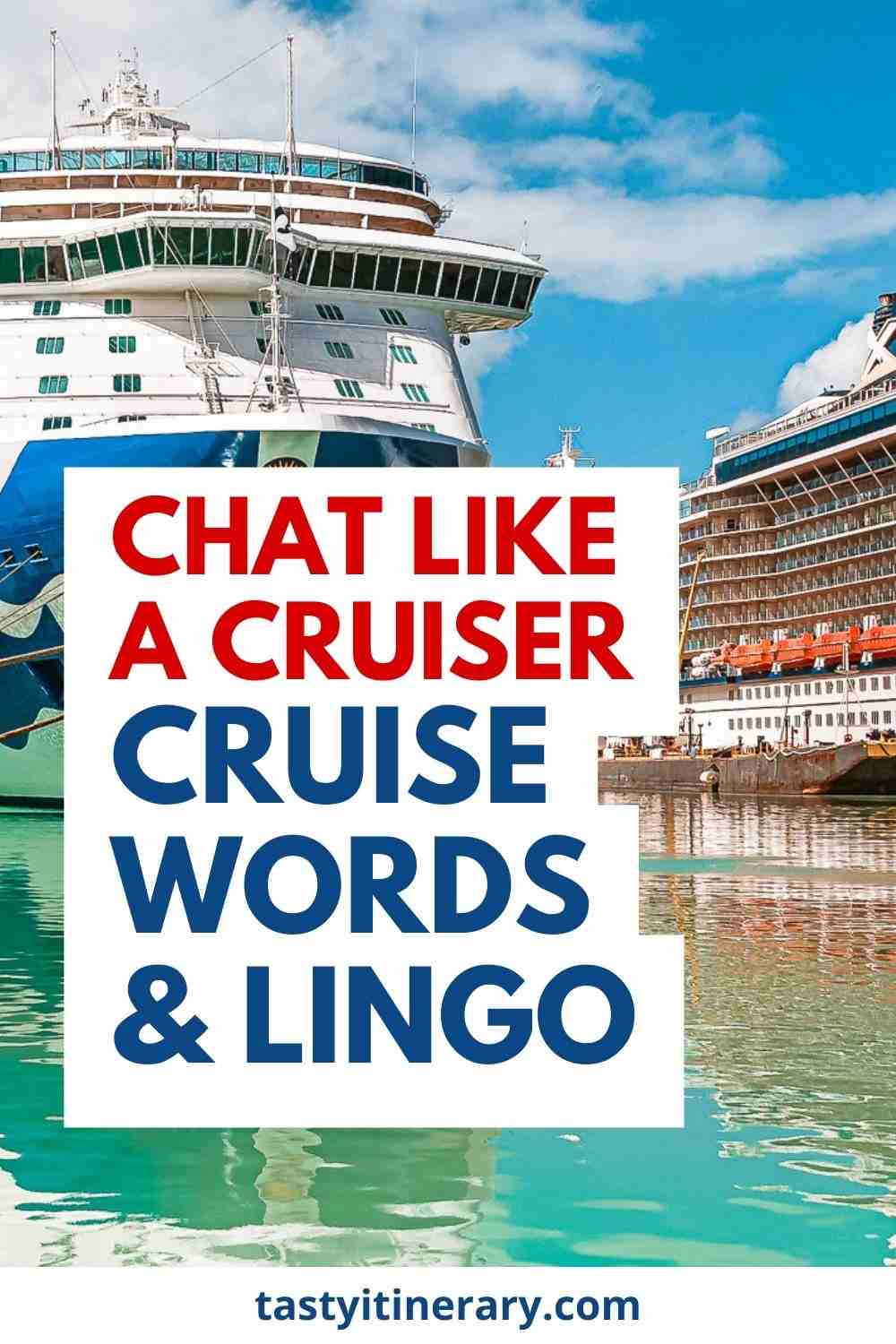
As you start planning your cruise, you’ll quickly realize there’s a world of cruise words to familiarize yourself with. Some cruise ship lingo might be straightforward, but others could have you scratching your head in confusion. Fear not—we’re here to demystify the jargon for you and quiz you for fun.
Soon, you’ll be chatting like a seasoned cruiser, effortlessly tossing around terms like “port” and “starboard,” “aft” and “bow,” along with “gangway” and “lido deck.” You’ll confidently navigate the ship, knowing your “muster station” from your “tender port” with the ease of a seasoned cruiser.
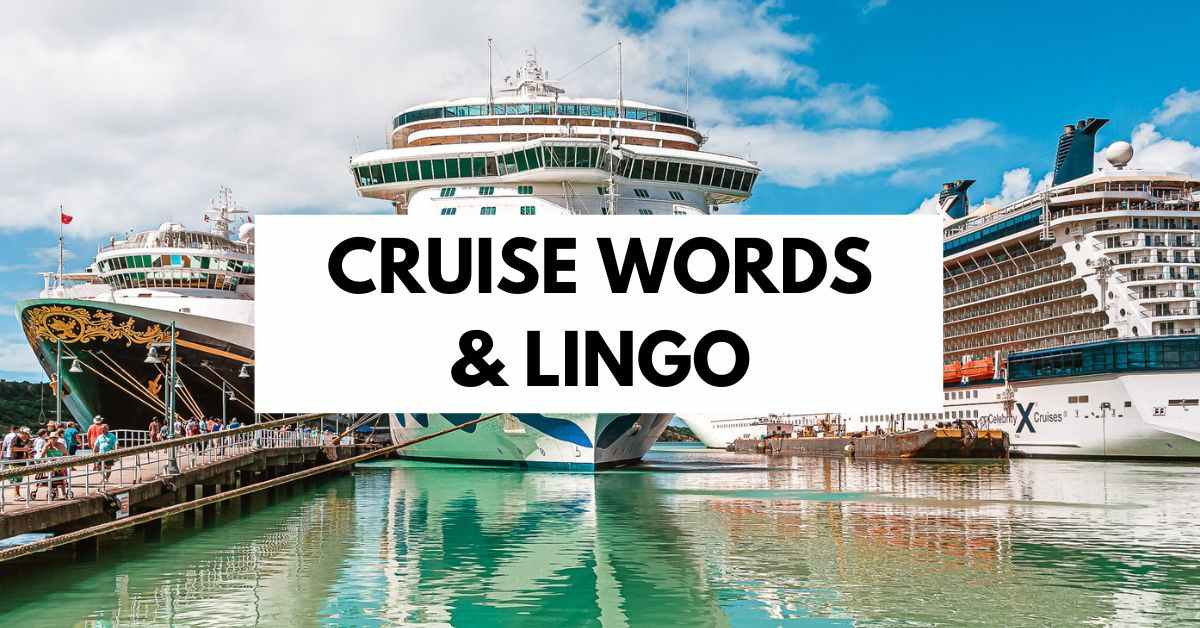
We won’t get into cruise vocabulary you may never need to know or use. We’ll stick to cruise ship terms you’ll find the most useful to understand. For fun, we’ve added a quiz below.
The most important cruise word you should remember is SHIP. It’s a SHIP, NOT a boat.
Table of Contents
Cruise Words and Its Definitions
Fundamental cruise ship lingo you should know from the start.
Let’s start with the basic cruise terms. Familiarize yourself with these keywords to lay the groundwork for your cruise lingo education. You’ll be coming across them frequently as you navigate the planning process.
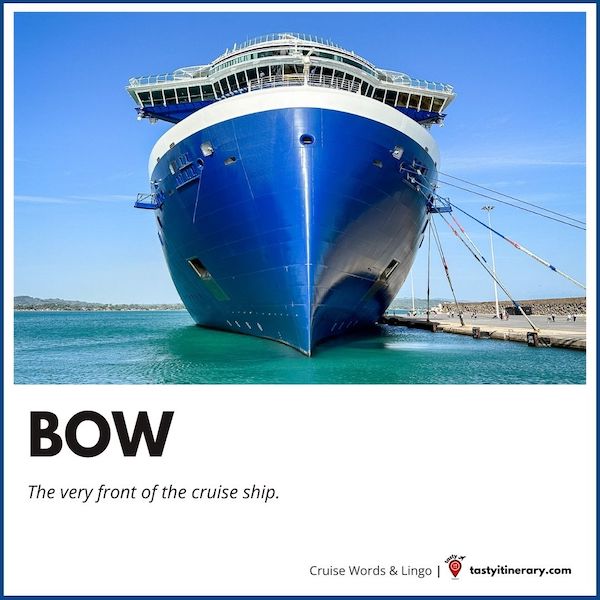
- Ship: a vessel designed for maritime navigation across oceans and large bodies of water, capable of carrying people and cargo long distances. You can fit boats inside a ship, but not vice versa.
- Bow : The very front of the ship.
- AFT : The rear or back part of the inside of the ship.
- Midship (MID): The middle area of the ship is often used to describe cabin locations.
- Forward (FWD): Refers to the area or direction towards the vessel’s front end.
- Portside : The ship’s left side, facing forward towards the bow.
- Starboard : The right side of the ship when facing forward.
- Port of Call : A port-of-call is a stop a cruise ship makes on its itinerary, where passengers can disembark to explore the destination. Also known as port destination.
- Tender : A small boat transporting passengers from the ship to the shore when the ship cannot dock at the port directly.
- Gangway : The entrance or exit ramp is used by passengers to board or leave the ship.
- Cabin or Stateroom : Your room on the ship can vary from interior rooms without windows to suites with large balconies.
- Sea Day : A day during the cruise when the ship does not dock at a port, allowing guests to enjoy the onboard amenities.
- Shore Excursion : Organized tours or activities in the port cities where the ship docks.
- Deck Plan : A map showing the ship’s layout, including cabins, public areas, and amenities, to help passengers navigate.
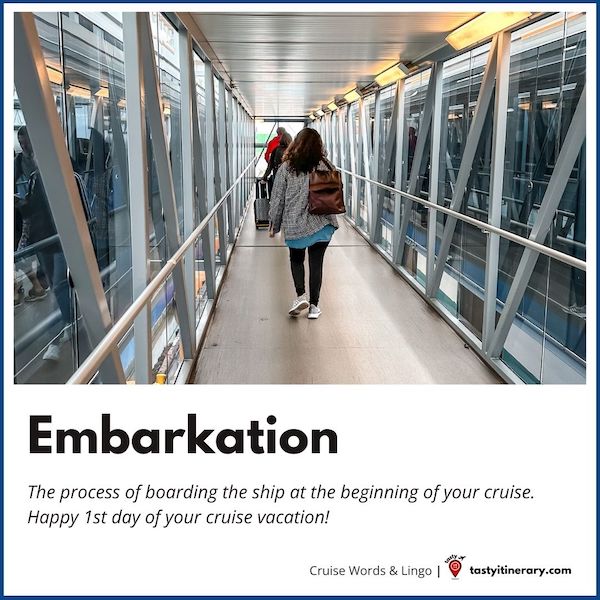
- Embarkation : The process of boarding the ship at the beginning of your cruise. You could consider it a happy day because it’s cruise vacation day #1.
- Disembarkation : The saddest day of a cruise vacation. The process of leaving the ship at the end of the cruise.
- Gangway : The entrance or exit ramp passengers use to board or leave the ship, typically when docked at a port.
- Muster Station : Previously defined, this term refers to a designated area where passengers gather during a ship’s emergency drill. Understanding your muster station is crucial for safety.
- Muster Drill : A mandatory exercise for all passengers and crew conducted at the beginning of the voyage to practice emergency procedures.
- Lifeboats : Small boats carried on the ship are used during an emergency evacuation. Knowing how to locate and access lifeboats is essential.
- Life Jackets : Personal flotation devices are provided in each cabin for every passenger. Familiarizing yourself with how to wear it correctly is a key safety measure.
- Cruise Agent : A travel professional or agency specializing in booking cruise vacations.
Other Cruising Terminology and Phrases You’ll Find Yourself Using Rather Quickly
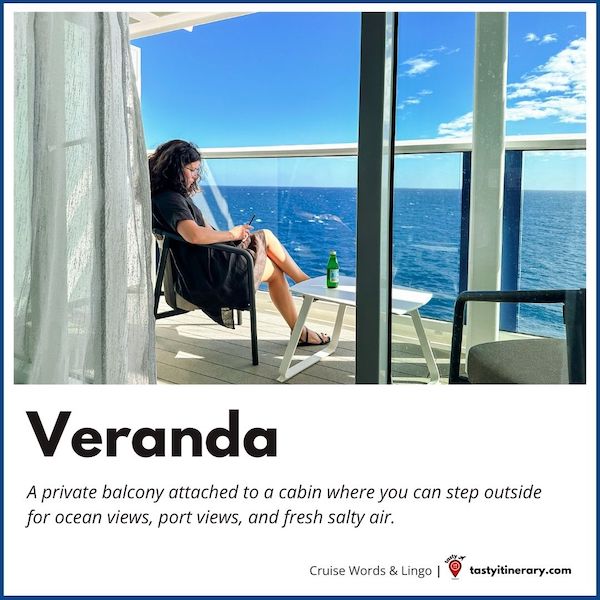
Let’s dive further into some other jargon popular in the cruise world.
- Passenger : That would be you, the cruiser, on a cruise ship.
- Cruiser : Another way to say a passenger on a cruise ship vessel.
- Seasoned Cruiser : Someone with extensive experience taking multiple cruises is familiar with the nuances of cruise travel.
- Cruise Card or Seapass Card: A personalized ID card is given to passengers upon boarding as a room key, onboard payment, and identification for disembarking and reembarking at ports.
- Cabin Category : The classification of staterooms based on size, location, and amenities, from interior cabins to luxury suites.
- Inside Cabin: A windowless cabin on the ship. Usually the most budget-friendly cabin.
- Oceanview (OV): A cabin featuring a window or porthole for ocean views.
- Veranda or Balcony : A private balcony attached to a cabin where you can step outside for ocean views, port views, and fresh salty air.
- Guaranteed Cabin (GTY): Cruise lines offer this booking option for a discounted rate where the passenger secures a cabin within a specific category or type at the time of booking. The exact cabin number is not assigned until closer to the sailing date.
- Freestyle Cruising : A flexible cruising style with no set dining times or seating arrangements and a relaxed dress code. This phrase is synonymous with Norwegian Cruise Line as the originator of freestyle cruising .
- Guest Services or Relations : The ship’s customer service desk is where passengers can inquire about accounts, lost items, and other services.
- Onboard Credit (OBC): Prepaid amount that is sometimes given to passengers by a promotion, agent, or cruise line to use onboard towards their bill.
- Gratuity : A daily tip for cruise staff , often automatically added to your onboard account, acknowledging their service.
- Itinerary : The cruise schedule detailing the ship’s travel plans includes ports-of-call and sea days.
- Sail Away Party : As the cruise sails from port on embarkation day, there is usually a huge celebration on the pool deck.
- Shore Excursion Desk : The place onboard where passengers can book and inquire about guided tours and activities at the upcoming ports of call.
- Towel Animal: The art of folding towels into various animal shapes is a fun and creative touch the cabin attendant may add to your cabin decor during turn-down service. Unfortunately, most cruise lines have stopped making towel animals, but Carnival Cruise Lines continues the tradition.
- Cruise Ducks : A fun tradition among passengers who hide and seek small rubber ducks around the ship for others to find.
- Wave Season : Refers to the time of year (usually January through March) when many people book their cruises, prompted by cold weather in the Northern Hemisphere and the cruise lines offering attractive deals and promotions.
- The Suite Life : The luxury experience of staying in a suite cabin on a cruise ship, offering VIP treatment, personalized service, and exclusive amenities.
- Back-to-Back (B2B) : When you book one cruise after another on the same ship when one cruise ends and the other begins.
- Closed Loop Sailing: When a cruise starts and returns to the same port.
- Obstructed View: When lifeboats or ship structures partially block a view from a cabin, you do not get a full ocean view.
Cruise Deck Terms
- Lido Deck : Often the hub of outdoor activities on the ship, the Lido deck is where you’ll find the main pool area, sun loungers, and sometimes, outdoor bars and buffets.
- Promenade Deck : This deck usually features a wide, outdoor walking area around the ship, perfect for a stroll with ocean views. The promenade might include shops, cafes, and other social spaces.
- Sun Deck : As the name suggests, this is an open deck area designed for sunbathing, offering plenty of loungers and, often, panoramic sea views.
- Pool Deck : Similar to the Lido deck, this area is focused on the ship’s swimming pools and accompanying leisure facilities, including hot tubs and poolside bars.
- Observation Deck : Located at the top of the ship, the observation deck offers the best unobstructed views of the ocean and the ship’s surroundings, making it the perfect spot for sightseeing and photography.
- Sports Deck : Dedicated to physical activities, the sports deck may include jogging tracks, miniature golf courses, basketball courts, and other sports facilities.
- Spa Deck : Typically housing the ship’s spa and fitness center, this deck is about relaxation and rejuvenation, offering treatments, massages, and fitness classes.
- Entertainment Deck : Home to the ship’s theaters, cinemas, nightclubs, and lounges, this deck is the heart of nighttime entertainment.
Cruise Dining Phrases
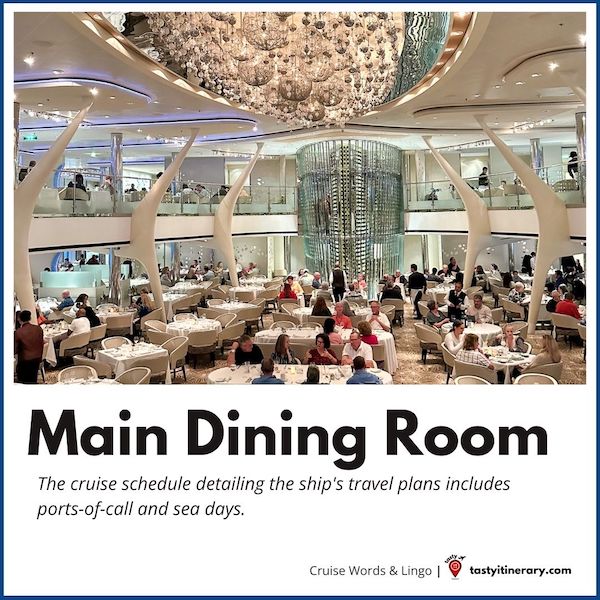
The dining experience is a large part of cruising. You should know These cruise words when delving into the dining scene on a cruise.
- Main Dining Room (MDR): The ship’s primary dining area, offering seated dining with various menu options, often included in your cruise fare. Sometimes, there is more than one main dining room.
- Buffet : A casual dining option on a cruise ship offering a wide range of options during breakfast, lunch, and dinner options. It’s self-service and usually included in the cruise fare .
- Specialty Dining : Onboard restaurants offering gourmet or special cuisine not covered by the cruise fare often require reservations and cost an additional fee.
- À la Carte : Dining options where each item is priced separately, unlike the set menu prices in the main dining room or inclusive fare at the buffet.
- Anytime Dining : Also known as “Your Time Dining” is an arrangement that allows you to eat your meals at any time during dining hours instead of scheduled seating times.
- Fixed Seating : Assigned dining times and tables for the duration of the cruise, offering a consistent dining schedule and tablemates.
- Room Service : Food and beverages can be ordered and delivered directly to your cabin. Some items and times may be free, while others incur a charge.
- Galley : The ship’s kitchen where all the food preparation happens. Some cruises offer galley tours.
- Chef’s Table : An exclusive dining experience offering a multi-course meal prepared and presented by the ship’s chef. It usually requires a reservation and an additional fee.
- Windjammer : Often the name for the buffet restaurant on Royal Caribbean cruise ships , providing various food options in a casual setting
Cruise Slang Used Regularly Amongst Cruisers
It’s not surprising that cruising has its own slang words. Whether used in a lighthearted manner or with a touch of annoyance, terms like “chair hogs” are part of the cruise community’s lexicon.
- Cruise newbies: They’re what we call first-time beginner cruises.
- Washy-washy : A fun phrase that reminds passengers to wash and disinfect their hands.
- Chair Hog : A person who gets up early to place towels or personal items on poolside loungers to “reserve” them for the entire day, often leaving them unoccupied for long periods.
- Cruise Control : A humorous term referring to the relaxed state passengers enter once they get used to the leisurely pace and routine of life on board.
- Landlubber : A playful term borrowed from old sailor vocabulary, referring to someone not accustomed to life at sea or who prefers to stay on land.
- Pier Runner : A passenger who returns to the ship at the last possible moment before departure, often seen running down the pier to avoid being left behind.
- Sea Legs : The ability to adjust to the ship’s motion and walk steadily onboard. “Finding your sea legs” means you’ve adapted to the movement and no longer feel unsteady.
- Shipfaced : A cheeky term for someone who has enjoyed perhaps a bit too much of the ship’s bar offerings.
- Naughty Room: This is where you’ll find your luggage if prohibited items are packed .
- One Uppers: Cruisers that brag about the many cruises they’ve taken and their loyalty status.
- Shipspotting: Watching and taking photos of cruise ships.
Type of Cruising
These are the most commonly discussed types of cruising within the cruise community .
- Mega Ships : Largest cruise ships worldwide, offering extensive amenities and entertainment options for thousands of passengers. Some of them are like theme parks at sea.
- Expedition Ships : Designed for adventurous travelers, expedition ships are equipped for exploring remote and off-the-beaten-path destinations, such as polar regions and exotic islands.
- River Cruises : Smaller vessels designed for navigating rivers, offering scenic voyages through picturesque landscapes and visits to historic towns and cultural sites along riverbanks.
- Luxury Ships : High-end cruise ships offer unparalleled service, amenities, and accommodations, catering to discerning travelers with refined tastes.
- Theme Cruise Ships : Specialized ships catering to specific interests or themes, such as culinary cruises, music-themed cruises, or wellness retreats, offering tailored experiences for enthusiasts.
- Yacht Cruises : Small, luxurious yachts offering exclusive and customized itineraries to exotic destinations, providing an intimate and upscale sailing experience.
Maritime Jargon and Technical Terms You’ll Most Likely to Hear
Although we may not be on the bridge to use these words, we often hear maritime jargon when the captain speaks and provides a daily update.
- Bridge : The ship’s control center or navigation room, where the captain and crew command the vessel.
- Berth : Refers to a bed on the ship or the ship’s docking location at port.
- Bulkhead : A vertical partition wall within the ship, providing structural support and compartmentalization.
- Stern : The back or aft-most part of the exterior of the ship.
- Gangplank : A movable bridge passengers and crew use to board or disembark from a ship.
- Helm : The ship’s steering apparatus or area from where the ship is navigated.
- Mooring : Securing the ship at a dock or berth with ropes or anchors.
- Nautical Mile : A measure of distance used in maritime navigation, equivalent to 1.1508 miles or 1.852 kilometers.
- Knot : A unit of speed equal to one nautical mile per hour used to measure the speed of a ship.
- Quartermaster : A crew member responsible for steering the ship and assisting with its navigation.
- Windward : The direction from which the wind is coming. Opposite of leeward.
- Logbook : An official record of the bridge, documenting the course of the journey, important events, and operational notes.
Crew Titles on a Cruise Ship
We can’t sail anywhere without the crew that not only keeps everything running and in tip-top shape. They also work hard day and night to ensure we have the best cruise vacation. You will often run into, see, or listen to these key cruise members over the ship’s intercom throughout the cruise. It’s good to add the crew titles to your cruise vocabulary/
- Captain : The highest-ranking officer on the ship, responsible for all operations, including navigation and safety. The captain has the final authority on board. The CEO of the cruise ship.
- First Officer : Also known as the Chief Mate, this individual is second-in-command and assists the captain in ship navigation and operations.
- Staff Captain : Often responsible for safety and security aboard the ship, including overseeing the crew involved in these areas.
- Hotel Director : Oversees all hotel services on the ship, including accommodations, dining, and entertainment, ensuring passengers’ comfort and satisfaction.
- Cruise Director : Responsible for all onboard entertainment and activities. The cruise director plans and coordinates events and announcements, playing a key role in the cruise experience.
- Purser : Handles administrative tasks, including passenger services such as billing and customer inquiries. The Purser’s Desk is the go-to place for guest assistance.
- Chief Engineer : The engineering department maintains and operates the ship’s mechanical and electrical systems.
- Executive Chef : Heads the culinary team and is responsible for all ship food planning, preparation, and presentation.
- Maitre d’Hotel : Oversees the dining room staff, reservations, and seating arrangements, ensuring a high-quality dining experience for passengers.
- Cabin Steward or Stateroom Attendant : Maintains the cleanliness and orderliness of passenger cabins, providing daily housekeeping services.
- Bartender/Bar Staff : Serves drinks and manages the bars on the ship, offering a variety of beverages to passengers.
- Deckhands : Perform various tasks related to the maintenance and operation of the ship, including cleaning and minor repairs.
Download a Glossary of Cruise Vocabulary
We created a simple glossary of all the terms mentioned in this post for easy reference. You can download a copy to print or save it.
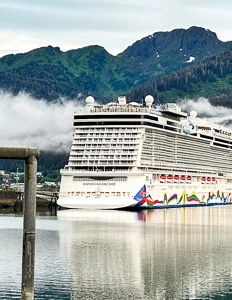
Quiz: Test Your Cruise Lingo Knowledge
What is the word for getting on a cruise ship.
The word for getting on a cruise ship is “embarkation.”
What are people on a cruise called?
People on a cruise are commonly referred to as “passengers” or “cruisers.” Virgin Voyages likes to call them “sailors.”
BEFORE YOU SET SAIL, HERE ARE SOME RELATED ARTICLES YOU DON’T WANT TO MISS:
- Plan a Cruise Trip With These Steps
- A Cruise Cheat Sheet of Tips
- Cruise Jokes and Memes That Will Make You Smile
- Motivating Cruise-Related Quotes
Meet Kathy Ava, a food, travel, and cruise writer based in Los Angeles/Pasadena, and the owner and main writer of Tasty Itinerary. With over 20 years of experience planning trips and logistics at her full-time job and for herself, she's become a pro at crafting unforgettable tasty itineraries. She's always on the hunt for delicious, fun travel destinations and cruise itineraries. She firmly believes that life is short and we must make the most of it, so always say yes to dessert.
Leave a Reply Cancel reply
Your email address will not be published. Required fields are marked *
The Ultimate Cruise Lingo Glossary – 85 Terms You Need to Know
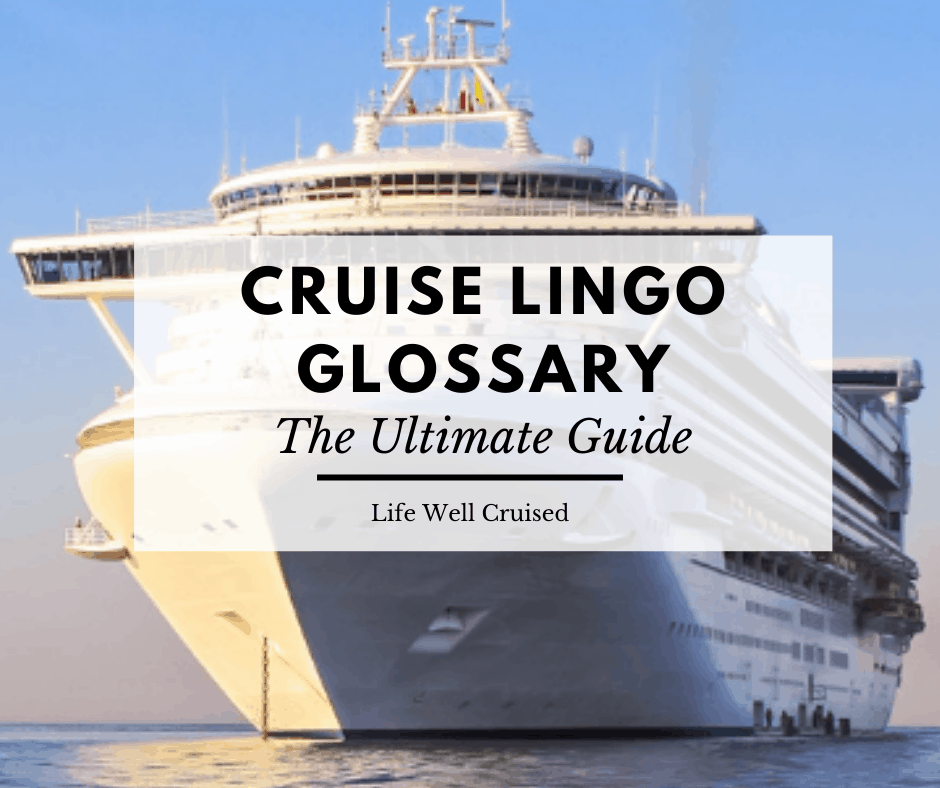
Sharing is caring!
Cruise vocabulary, jargon or lingo – if you’re going on a cruise, you’ll want to be familiar with the cruise terminology
Are you getting ready for your first cruise? Through the planning process, you may have noticed that there’s a whole world of cruise vocabulary, nautical terms or “cruise lingo”.
This handy glossary of cruise terminology includes some of the new terms and acronyms used in the cruise industry today. These are some of the most common cruise phrases and words you’ll be hearing as you plan your cruise, as well as when you board your cruise ship.
This post contains affiliate links which means if you click and buy that I may make a commission, at no cost to you. Please see my disclosure policy for details.
As an Amazon Associate I earn from qualifying purchases.
A Cruise Lingo Tip You Must Know
Before we get started, here’s the most important piece of advice I can give you, when it comes to talking like a cruise pro.
Don’t call a cruise ship a boat.
Cruisers might have different opinions about which cruise lines are the best, cruise line dress codes , and the do’s and don’ts of cruise gratuities , but there’s one thing all cruisers agree on…
Don’t call a cruise ship a boat. Trust me on this 😉
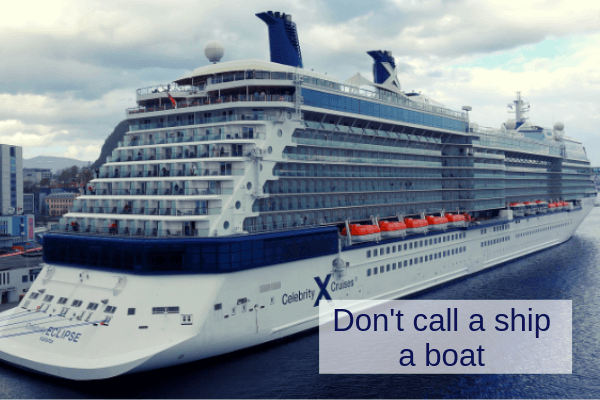
About Cruise Lingo and Cruise Lifestyle
Cruising is a lifestyle unto it’s own, and cruisers really do have their own lingo and cruise terminology. Nautical terms are often used, and cruisers love it!
New cruisers can be left scratching their heads.
Words and acronyms such as Aft, Muster drill, Starboard, OBC and MDR, may seem like a mysterious cruise language. However, in this cruise lingo glossary, I’ll go over all the cruise jargon need to know.
You’ll be chatting like a seasoned cruiser in no time!
Cruise ship vocabulary
You’re on a ship, not a boat. A boat fits inside a ship, and not the other way around. Fellow cruisers won’t hesitate to correct you sternly if you get this wrong.
Try and get used to this one quickly, just trust me on this…
Below you can hear Celebrity Cruises Captain Kate , explaining this point in her navigational report.
Your room is called a cabin. While hotels have rooms, ships have cabins.
3. Stateroom
Sometimes a cruise cabin will be referred to as a stateroom.
Your cruise ship will have many decks. While hotels refer to floors, cruise-ships refer to decks.
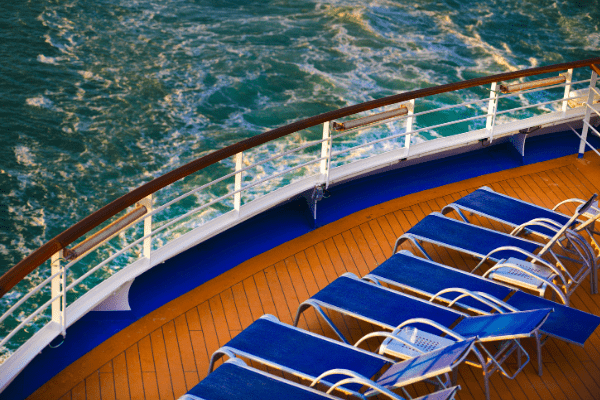
5. The bridge
The bridge is the navigational hub of the ship.
The person in command of the ship.
7. Cruise Director
Think Julie McCoy :-). Your cruise director, among other duties, will act as Emcee, heading up most major entertainment events on the ship. On larger ships you’ll see assistant cruise directors and other activities staff also leading main activities.
8. Itinerary
Your cruise itinerary refers to each destination/cruise port of call you’ll be visiting.
9. Port of departure
This is the port from which your cruise will depart (ie. Miami, Fort Lauderdale, Vancouver, Barcelona etc.)
10. Cruise terminal
Just like airplanes have airports, cruise ships have cruise terminals or cruise ports. There are safety and boarding procedures to be aware of.
Recommended: 11 Cruise Boarding Tips You Need to Know
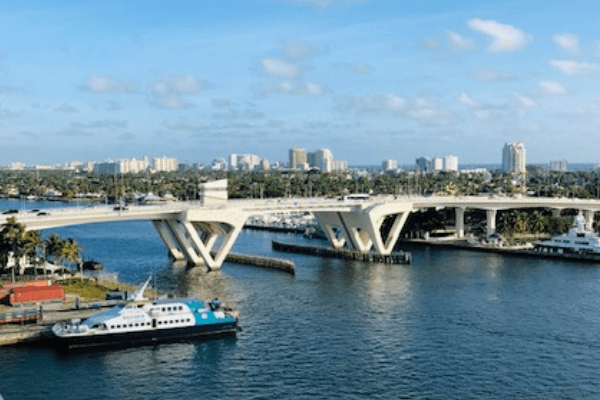
11. Ports of call
You probably remember this one from “The Love Boat”. I know I do! This is individual destination where you will stop at for the day. Examples of cruise ports or ports of call on a Caribbean cruise include Cozumel , St. Thomas , Grand Cayman and so on.
12. Shore excursion
This is an organized activity you may choose to do when in a port. You can book a shore excursion through your cruise line or on your own with a private vendor or tour company. Examples include a snorkeling or sightseeing excursion.
A cruise ship will usually arrive at a large dock when it arrives at the cruise port.
There are some cruise ports where cruise ships cannot access the land directly and dock, due to coral reefs and other reasons. In these cases your ship will tender a few minutes away from the port, and shuttle passengers in by tender boats.
As an example, Grand Cayman is a tender port at this time, but it looks like a new dock will be built in a couple years.
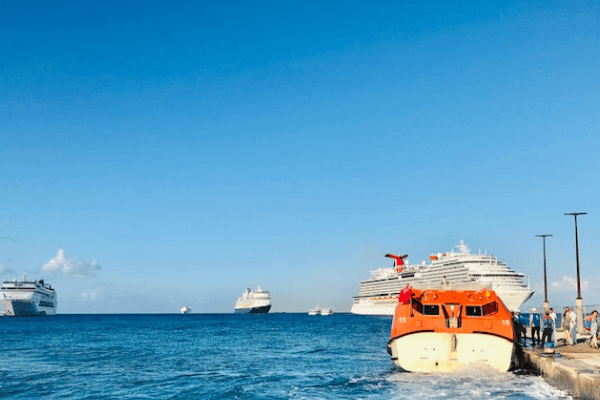
15. Stabilizers
Modern cruise ships have stabilizers to keep motion to a minimum.
The ship’s anchor is impressive. Along with the chain, the anchor holds to the sea bed to keep the ship from drifting at sea.
The super large kitchen where literally tons of food is cooked and prepared. You can actually do a galley tour while on your cruise if you’re interested.
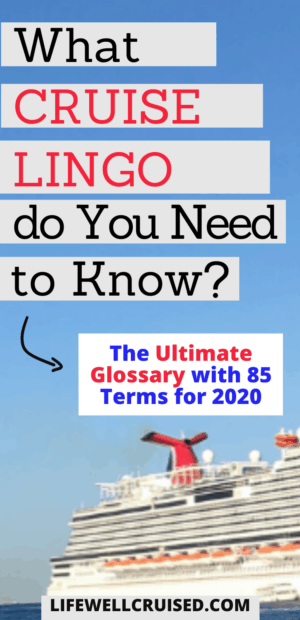
18. Dry dock
When a cruise ship goes into dry dock, it’can be to receive routine maintenance, or to be refurbished. the ship can be out of service for weeks or longer.
19. Charter
Groups will sometimes charter a cruise ship, to host a special event.
Cruise Ship Terminology – understanding common areas of the cruise ship
The atrium is a large central public area usually spanning 3 or more decks. Often very beautiful, it will be the central hub of the ship’s interior.
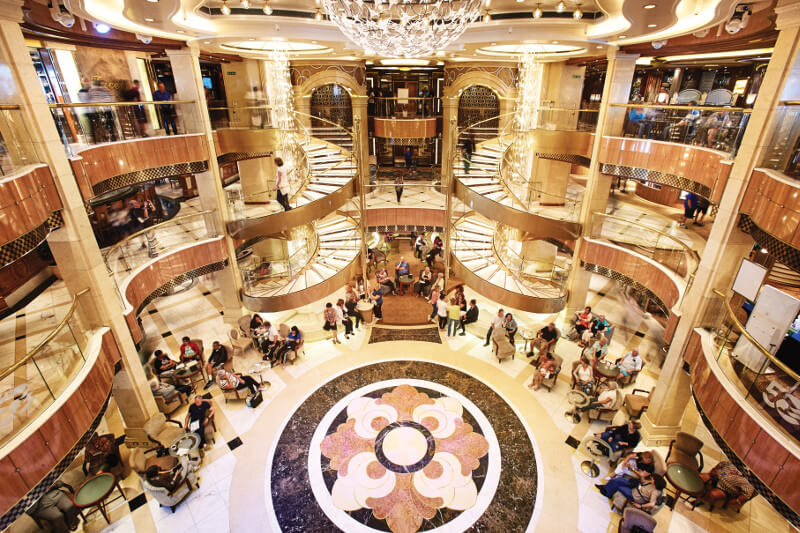
21. Port side
The left side of the ship, as you face forward, is referred to as port side .
Tip: An easy way to remember – LEFT has 4 letters and so does PORT
22. Starboard side
The right side of the ship as you face forward is the Starboard side.
23. Forward
The front section of the ship.
The back section of the ship is called the aft. The aft or wake view is a favorite for many cruisers.
25. Purser’s desk
These days, the purser’s desk is often referred to as guest or passenger services. However many avid cruisers enjoy the nautical language and will continue to use the term “purser’s desk”. Usually this is located in the atrium.
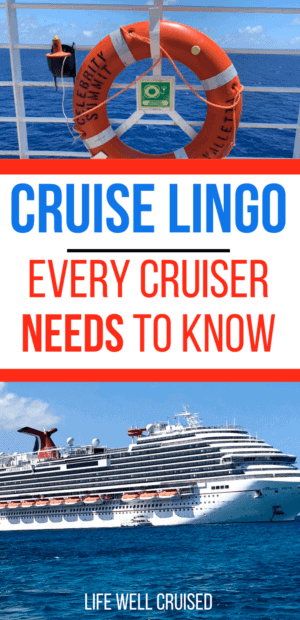
26. Mid-ship
Generally said in reference to the preferred cabin location . Most cruise passengers will prefer a mid-ship cabin, rather than one that is forward or aft. This area has an advantage of having more stability in general.
Get The Ultimate Cruise Planner
Regular price: $27 now just $17.
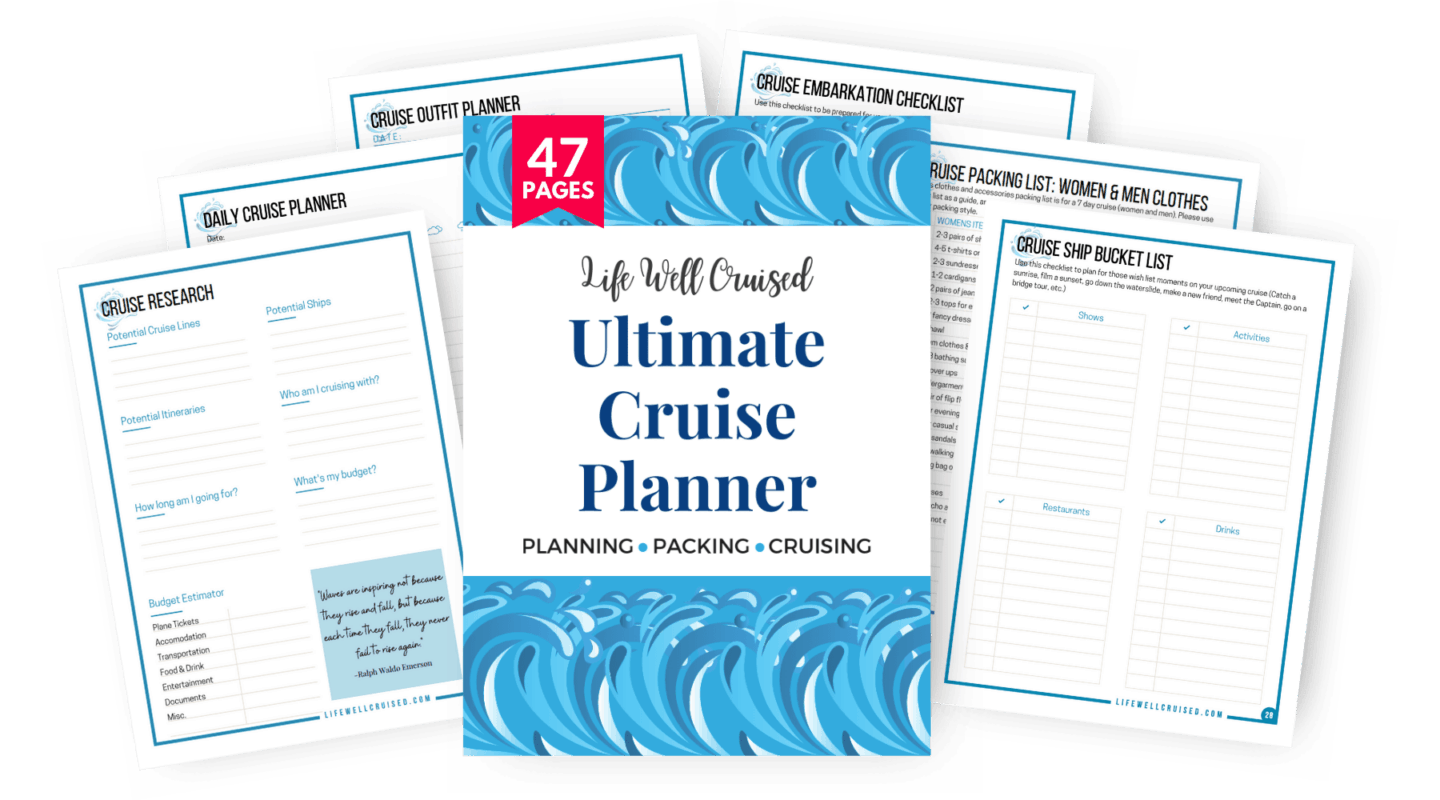
Cruise Cabin Terminology
When booking a cruise, you’ll notice that there are several different stateroom options. Below are the most common cabin options.
27. Interior staterooms
Inside or interior cabins are staterooms which include all the basics, however do not have a window.
Related: 15 Best Tips for Cruising in an Inside Cabin: cabin organization and more
28. Oceanview Cabins
Cabins with a window or porthole are ocean view cabins.
29. Balcony cabins
Balcony cabins , sometimes referred to as Veranda cabins, include a private outdoor space outside your cabin.
Related: 7 Best Reasons to Book a Balcony Cabin
30. Guarantee cabin (GTY)
This refers to an unassigned cabin any type of cabin (inside, ocean view, balcony) . The cruise line will assign the cabin at any point before the cruise.
Often, guarantee cabins will be priced lower, so this can be a great value if you’re not picky about the location of your cabin.
31. Pullman bed
If you have more than 2 passengers in your cabin, you may have pullman beds for 3rd and 4th passengers. They are like bunk beds that come out of the wall or ceiling. They will be tucked back into the ceiling or wall during the day if you like.
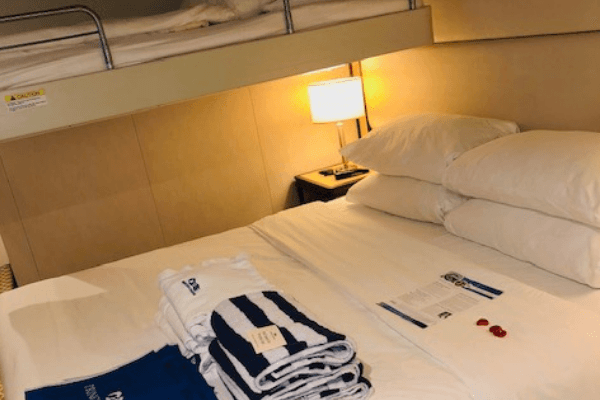
32. Double occupancy
The cruise fare will be based on double occupancy as a standard, and this is what you will see as an advertised price.
33. Single occupancy
When cruising solo, most of the time you’ll be paying a single occupancy rate, which can be almost the cost of 2 people in a cabin (you won’t pay taxes twice).
34. Solo cabins – Studio cabins
If you’re cruising solo, look for cruise ships that have studio cabins intended for solo travelers.
35. Triple and Quad Cabins
Some cabins can accomodate 3, 4 or more passengers in one cabin, referred to as triple or quad cabins. These are most popular with young families cruising together .
Read next: Worst Cruise Ship Cabins to Avoid
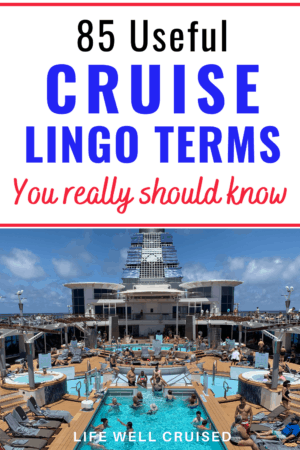
Back to the Cruise Ship
36. Deck plan
A map of all the cruise ship decks.
37. Lido deck
The Lido Deck is the public pool deck, often on one of the top decks of the cruise ship. There may be more than one pool, hot tub and outdoor seating.
38. Gangway
The gangway is elevated walkway you will use to board your ship, usually covered, but not always.
The very front of the ship.
The very back of the ship.
The beautiful white trail of waves visible at the very back of the ship. My favorite spot on the ship to realx and take it all in. Please let me know in the comments if this is your favorite as well – if not, where is?
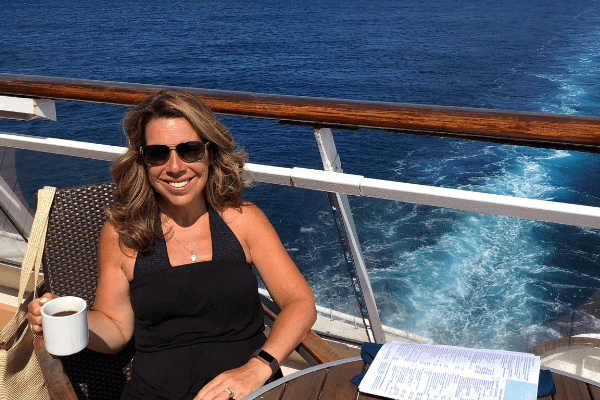
Cruise Lingo you need to know for the first day of your cruise and beyond
42. Embarkation day
The first day of your cruise and the best day in a cruiser’s life 😉
Recommended reading to prepare for your cruise embarkation day – 25 Cruise Embarkation Day Tips Straight from the Pros
43. Muster drill
The muster drill is a mandatory safety drill which is done prior to sailing. Note, it’s not “mustard” drill, as you just may hear from other passengers.
44. Muster station
Your assigned emergency meeting location. You’ll likely meet here for your muster drill, but don’t worry, cruise ship crew will help to guide you.
45. Daily planner
Different cruise lines use different terms for their daily newsletter of information scheduled activities (Cruise Compass, Princess Patters, Today, Freestyle Daily). Many cruise lines now have this information available on their app.
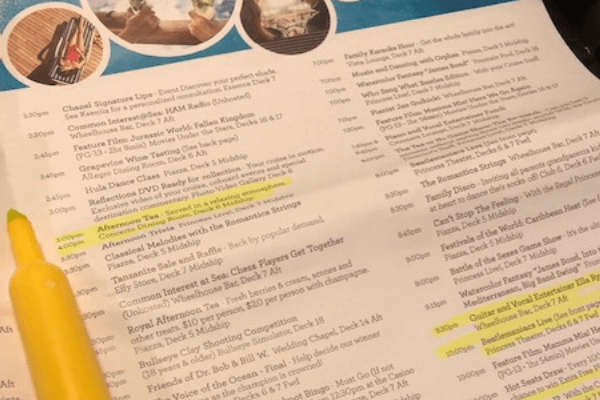
46. Sailaway
The period of time that your Cruise Ship actually sails away from the shore. Often there will be a Sailaway party on the top deck, however some cruisers enjoy it from their own balcony.
47. Sailaway Party
Check your daily planner for information. Generally the Sailaway party will be at the main pool and will include some drinks, a DJ or band playing and some dancing.
48. Sea day
A day at sea is when your cruise ship is not visiting a port, but sea days aren’t boring ! There will be plenty of activities to choose from if you don’t want to simply relax by a pool.
49. Cruise Card
On most cruise ships, you’ll be given a cruise card which will act as your room key, ID and your method of payment when on your cruise.
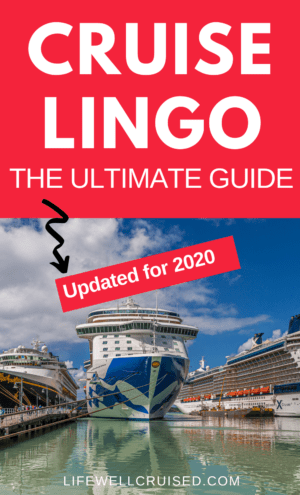
50. Ocean Medallion
Ocean Medallion is a relatively new cruise ship technology available on Princess Cruises . Instead of a cruise card, the medallion serves like a cruise card, but also does much more.
You can read about our recent Ocean Medallion experience here .
51. Room steward or cabin attendant
Sometimes mistakenly called a room “Stuart”, the person who cleans your room twice a day (amazing!) and really takes care of you and your cabin mates is called a room steward or a cabin attendant.
52. Dress code
Cruise lines have suggested dress codes , ranging from very casual to more formal.
53. Formal night
A tradition on many cruise ships, the formal night is a night to dress up. Check your cruise line’s dress codes for suggestions. Some cruise lines have relaxed the dress codes a bit, including Celebrity Cruises which now has Evening Chic , rather than formal.
54. Early dining and late dining
Early and late dining are basically a first and second seating, which some cruise lines with an option of assigned dining will have. This is for a main dining room and not a buffet.
55. Open dining
Open dining is offered on many cruise ships. In some cases, a cruise line will offer both open and set dining. It can go by different terminology including Anytime Dining on Princess , My Time Dining on Royal Caribbean, Select Dining on Celebrity .
To note, some cruise lines offer only open dining, such as Norwegian Cruise Line which is Freestyle dining.
56. Specialty restaurants
This usually refers to the dining in an alternative restaurant that is not included in your cruise fare and is often a more intimate or higher culinary experience. An example of this would be Celebrity Cruises Tuscan Grille .
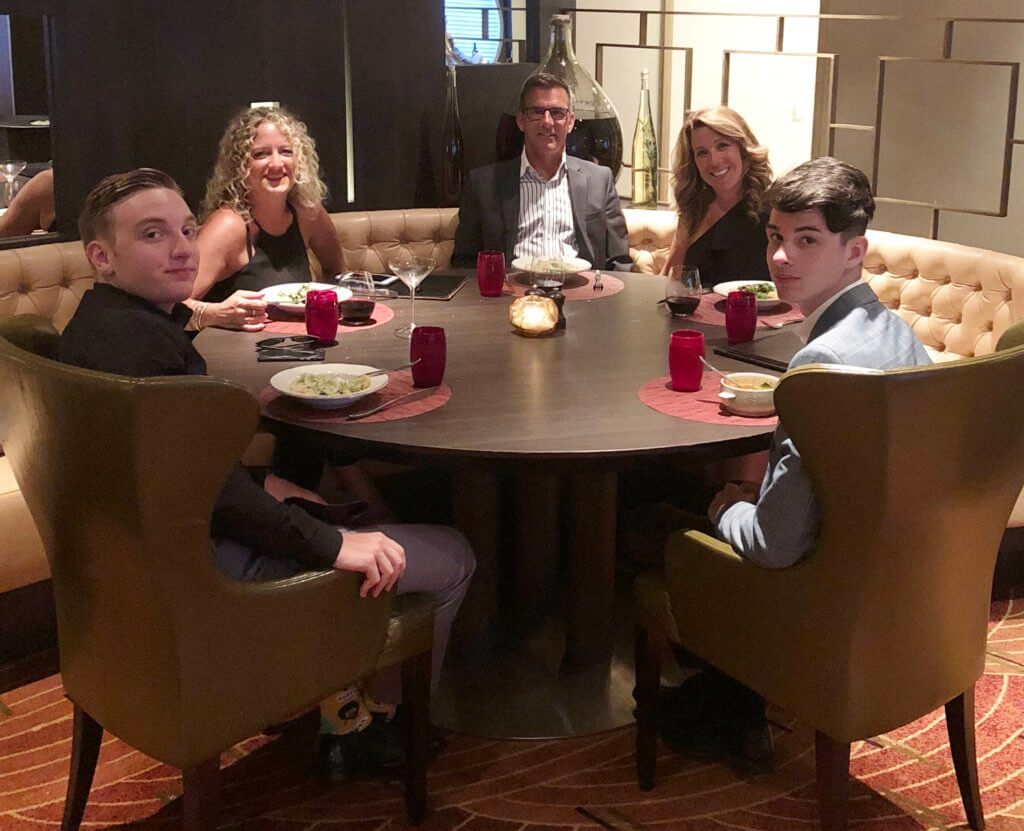
57. All Aboard
The ship will leave your ports of call promptly. All aboard time is generally set for 30 minutes before your cruise is scheduled to leave the port of call. Do verify the all aboard time before heading off for an excursion in the cruise port.
All joking aside, there are people at cruise ports every year – and you don’t want it to be you.
58. Towel animals
You just may find towel animals in your cruise cabin. These are the super cute towel creations made by your room steward, available on some cruise lines (usually family orientated ones).
We’ve had many years of enjoyment when our kids were young, even miss them a little bit these days.
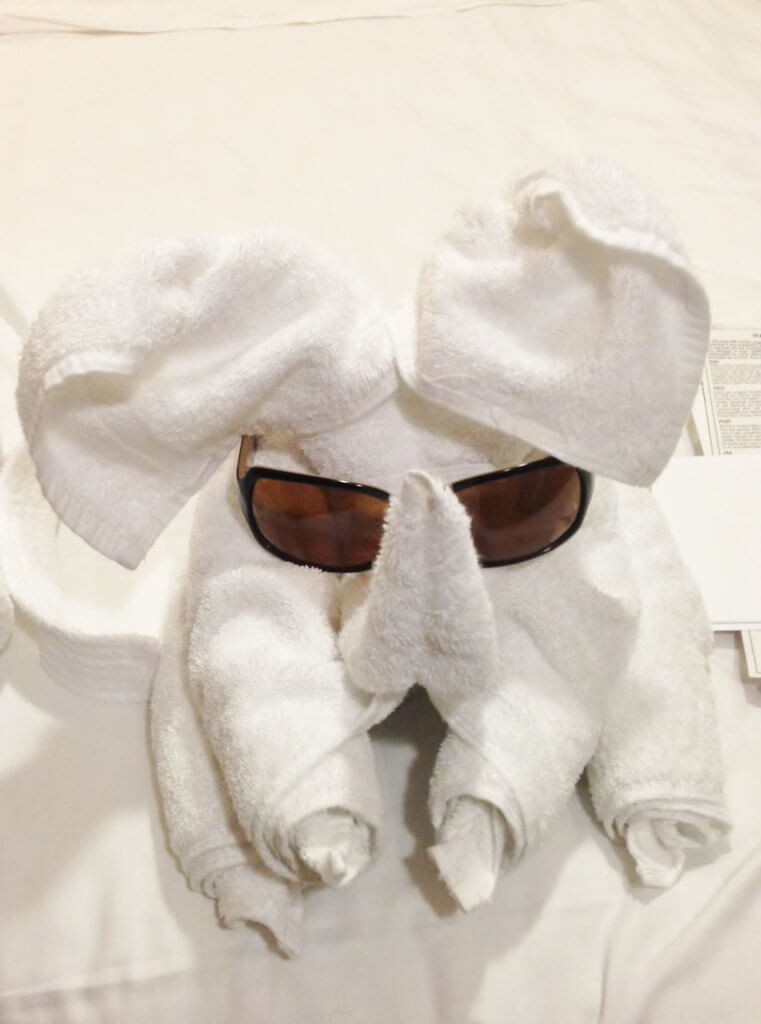
59. Pier runners: This is an unofficial name given to those (who may have had too many libations) who can be seen running in the last few minutes hoping not to miss the ship’s departure. It is quite entertaining!
60. Roll call
A roll call may be set up for your cruise by yourself or other cruise passengers. Basically, this is a group of people who chat online before a cruise, and may have some gatherings set up once on board.
Read more: 5 Reasons Why You Should Join a Cruise Roll Call
61. Disembarkation
The saddest day in a cruiser’s life is the day that you need to disembark and the cruise is over.
Wondering about how disembarkation day really works? 21 Cruise Disembarkation Tips You Need to Know
62. Onboard booking
Booking your next cruise on board can give you some awesome benefits and is one of the best kept secrets for saving money while booking a cruise . For those that book with travel agents, don’t worry, the future cruise consultant will transfer it to the agency (request if they don’t offer).
Tip: Check to make sure about the terms and conditions and find out if future cruise deposits are refundable if that’s important to you.
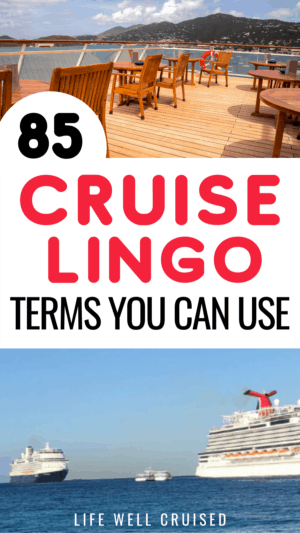
Booking a cruise – terms to know
63. Cruise fare
This is the base cost of the cruise, per person
64. Deposit and Final Payment
When you book a cruise, if you’ve booked early you’ll be making a deposit which will secure your booking. As you get closer to sailing (usually about 70-90 days pre cruise), your final payment will be due.
Terms and conditions may be different on various cruise lines, however the details will be on your own reservation.
65. Cruise contract
When booking a cruise, you’ll be agreeing to a cruise contract. The cruise contract includes the terms and conditions that cruise passengers agree to.
66. Online check-in
Before your cruise, passengers are asked to complete an online check in and print out cruise documents to sail.
67. Gratuities
Gratuities or tipping is customary on a cruise. A per person service fee or gratuity will be charged daily to your cabin, on most major cruise lines.
Recommended: Cruise Tipping Guidelines and Etiquette
68. Prepaid gratuities
When booking your cruise, you can prepay your gratuities , and avoid thinking about additional expenses on a cruise .
69. Lanyard
A lanyard might be used by cruisers to hang a cruise card around the next for convenience. This is one of the most popular cruise accessories in our list of travel essentials .
70. Rum Runners
A type of container used to conceal alcohol brought on a cruise, that isn’t allowed. For more on other items that are prohibited, read this next: 33 Banned Items You Can’t Bring on a Cruise
Recommended: 10 Things NOT to pack for a cruise
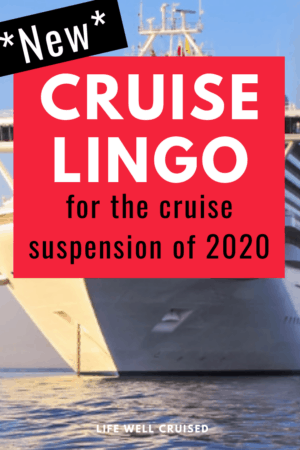
Cruise Start Up Terms
Along with some major changes on cruise ships, we have seen new cruise line policies the have resulted in more cruise lingo – more words and explanations we just don’t know.
71. Cruise with Confidence
The major cruise lines introduced a flexible cruise cancellation policy, during this time, should people decide to cancel a cruise up to 48 hours pre-cruise. When cancelling, in most cases passengers will receive a credit which can be used towards a future cruise.
There are some terms and conditions to be aware of, so always read the fine print.
72. Muster 2.0
A new technology that would allow muster drills to be done using a new app, rather than in a large gathering. Royal Caribbean and Celebrity Cruises came out with this new technology as cruises resume. Several cruise lines are using a form of emuster as well.
The Cruise Line International Association is the world’s largest cruise industry trade association. It represents the major cruise lines, which have suspended cruises leaving from the United States until the end of October .
74. No Sail Order
A no sail order was put into effect by the CDC in March 2020. For cruises to resume, it was imperative that the CDC lift the no sail order . This is lifted and cruisers have resumed with strict guidelines for safety and health.
75. Warm lay up and cold lay up
As cruises are suspended, we hear the terms “warm and cold lay up” of cruise ships.
Warm lay up refers to when a cruise ship has reduced levels of crew onboard, and costs for fuel and other items are reduced. However, the cruise ship is kept in a condition as to be able to be brought back to service relatively quickly.
A cold lay up is a prolonged period of time when the cruise ship is shut down as much as possible to reduce cost. It takes longer for ships to be brought back to service and is a more complicated process.
76. NEW Safety and health protocols
The cruise lines have adopted new safety and health protocols to ensure safe cruising for passengers and crew.

Cruise Lingo Acronyms
It’s quite common to hear people who cruise a lot speak using these acronyms. You may even see these abbreviations in cruise facebook groups and pages, or on cruise forums .
Here is an explanation of the most common cruise acronyms, so you’ll be fluent in cruise lingo of all sorts.
Main Dining Room
On board credit – extra cash credit on your cruise account that you can use on the ship for most purchases. Sometimes this is added as a promotion by the cruise line or your travel agent.
This refers to a back to back cruise, meaning one cruise and then another cruise one after the other. Some cruisers may even do a B2B2B (3 cruises in a row)
The abbreviation for a guarantee cabin (see above in cruise lingo glossary)
Future Cruise Credit – when booking a future cruise onboard
A TA is short for travel agent
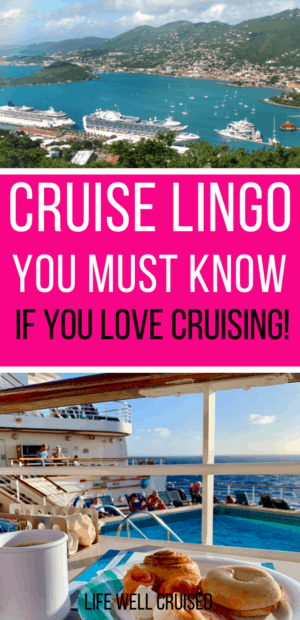
Avid Cruiser Lingo
83. Cruisebug
After a first cruiser, it’s not uncommon for a new cruiser to love it so much that they feel an immediate calling to book again and cruise more often. Often, this is referred to as catching the cruisebug.
84. Cruise addict
It’s said that cruising is the healthiest addiction and a vice many are happy to have! If you’ve cruised and now you’re constantly on the lookout for all the cruise info you can find and really just want to book cruises, congrats! You are now a cruise addict!
85. Cruiseaholic
Another word for someone who is addicted to cruising!
Recommended: 30 Best Gifts for Cruisers (that are unique too!)
86. Thallosphile (n)
A lover of the sea , someone who loves the sea, ocean.
87. Post-cruise blues
So, the post-cruise blues is real! One possible remedy is booking another cruise when onboard, but it’s still tough to leave that amazing cruise ship life!
Do you suffer from Post-Cruise Depression?
How To Know if You Have Post-Cruise Depression (a fun read)
*Ultimate Cruise Travel Planner*
Over the last year, I put together a 47 page cruise travel planner that has everything you need as you plan and get ready for your cruise.
If you could use cruise packing lists, to-do checklists, shore excursion forms and more, you’ll love the Life Well Cruised Ultimate Cruise Planner .
Plus, for a limited time, it’s $10 off. Hope you enjoy!
See details here: Ultimate Cruise Planner -What’s Included
Related and Popular Posts:
Port Side or Starboard Side on a Cruise: Which Side is Best?
37 Interesting Cruise Ship Facts that Will Surprise You
50 Most Popular Amazon Cruise Essentials
25 Cruise Embarkation Day Tips You Need to Know
75 Genius Cruise Hacks and Tips
23 Essential Things to Pack in Your Cruise Carry-On Bag
What to Pack for a Caribbean Cruise
Worst Cabins to Avoid on a Cruise
Recap: Cruise Lingo Glossary – 85 Cruise Terms You Need to Know
In this post, we went over 85 cruise terms that are important to know when you’re booking a cruise, as well as when you’re on a cruise ship. This list of “cruise lingo” should help to navigate the world of cruise language.
If you’re a new cruiser I hope the information has been helpful. If you’re a seasoned cruiser, I hope it was a fun read!
Is there a cruise term that you think should be added? Please let me know by leaving a comment below.
Happy cruising!
P.S. If you’ve enjoyed this, please don’t keep it to yourself ;-)! Please share it with a friend, on Facebook or save for later on Pinterest. Thanks so much!
Let’s connect:
Follow me on YouTube at Life Well Cruised
Follow me on Facebook at Life Well Cruised
Follow me on Pinterest at Life Well Cruised
Follow me on Instagram at Life Well Cruised
18 Comments
You missed out Rum Runners. Those cheapskates that think its clever to smuggle on alcohol rather than buy on board in various containers. This may be a Carnival thing but its creeping on the better lines.
You’re right – I completely forgot that one and it’s now totally in the cruise lexicon, right? For better or for worse, lol!
I’ll add it in. Thanks for taking the time to comment :-)!!
by the way what happens to the “Rum Runners” when caught?
Hmmmm,good question. I actually have heard that any alcohol will simply be confiscated, but I’ve never used them so I can’t say for sure.
I love the drinks on board, so I just drink those 🙂
Thanks for taking the time to comment Lebo.
I really like your blog/page. The information in it is very good. I am a member of the Princess Cruise forum and what I have done is when I have come across something interesting or information I didn’t know I take notes on it. That’s how I’ve learned many of the items here. I would add TA – which is travel agent may seem too simple But I see TA all the time. I liked your comment about if you don’t know something ask a fellow cruise passenger or staff person on board. Since I am a solo travelor that really helped me. I would also add to tips for new cruisers is to be respectful of their fellow travelors and also all staff they encounter onboard (which includes room stewards, wait staff and everyone else they encounter).
Hi Charles,
Great points! TA is one I overlooked and you are so right. I agree completely with respect for passengers and crew – I hope most are.
I really appreciate you reading my blog and taking the time to leave a comment!
All the best,
This is great, but I would have liked a short, printable list, as well.
Glad the list was helpful. Thanks for your suggestion as well. This may be something that I’ll work on doing in the future.
I love your cruise blog. I have the cruise bug bad. PCD is bad in me on disembarkation day. I have only cruised with NCL and when onboard I buy as many CruiseNext Deals as I can. Many times you buy one and get on free, and on balcony and higher you can use two. To me free money off my cruise. NCL has past guest deals and when on bourd I book it. Thus even getting a better deal. I will triple dip looking for a past guest and a Latitudes Reward program. Earn point for every cruise night, Point for Suite, point booking 9 mounts in advance, and point for a Latitudes insider offer. Next cruise I will earn many points per day. That gives you free laundry, free dinners, free bottles of wine at dinner, and hopefully one day a free cruise… I would like to do a B2B2B. Do you have to get off the ship? Only word I would add is RESPECT. Respect yourself not making a scene if something not right. For you are the lesser for it. Hopefully one day we will meet up on a cruise ship. Your friend Russell
Thanks Russell for your kind words and your great tips! I have the same sentiments on disembarkation day – it’s the worst :-(.
For a B2B, you do have to get off the ship (although I hear sometimes not if customs come on), but it’s a pretty good process as passengers are grouped together and passed through quickly.
Would be great to meet you on a cruise one day!
Yes a printable list of the terms would be very helpful. Tyvm for your time to help fellow cruisers!!
Thanks Deborah for your comment. I’ll definitely look into creating one, especially since it’s been suggested a couple of times.
Best to you,
We too had a stressful private tour in Turkey, going to Ephesus. We made it back by the skin of our teeth, but the traffic on he way back through Izmir was heavy and slow. All your tips about not being a pier runner are very apt! Thank you. Jim and Norita Nickerson
Hi Jim & Norita,
Wow I would have been stressed as well. We loved Ephesus but did a morning tour only so were back early. Thanks for sharing your experience!
Not only do I find your newsletters fun AND helpful but ditto your You Tube videos. I have been addicted to cruising since 1959. Wish I could afford to feed my addiction more frequently. Going on an 11 day Caribbean cruise on Rotterdam VII in December.
Thanks so much Jim! I’m so glad that you enjoy my emails and videos & appreciate you taking the time to comment.
Don’t we all just wish we could cruise a little more? Your Caribbean cruise sounds absolutely amazing – enjoy every minute!
I enjoy your work … 2 more often overlooked terms: bunkering and along-side … bunkering of course is the re-fueling process … along-side is the captain’s term for bringing a ship to a full stop at a future pier (“we’re expected to be along-side at 7 am in Fort Lauderdale”) …
Thanks for sharing these!
Leave a Reply Cancel reply
Your email address will not be published. Required fields are marked *
This site uses Akismet to reduce spam. Learn how your comment data is processed .
- Cambridge Dictionary +Plus
Meaning of cruise in English
Your browser doesn't support HTML5 audio
- They're going on a cruise round the Med.
- They've just set off on a round-the-world cruise.
- Do you dream of a luxury skiing vacation or a Caribbean cruise?
- age of sail
- ocean-going
- under sail idiom
- They are cruising off the west coast of Vancouver Island.
- Thousands of spectators watched the tall ships cruise the Detroit River.
- After launch , the probe will cruise for 6 months before intercepting the comet beyond Earth's orbit .
- The car is more fuel efficient because the engine can run on just three of six cylinders when cruising.
- A guy cruised up in a convertible and offered me a lift .
- He goes cruising the streets looking for places to rob .
- Our department is doing all the work while the rest of the business is cruising.
You can also find related words, phrases, and synonyms in the topics:
Related word
Cruise | intermediate english, translations of cruise.
Get a quick, free translation!

Word of the Day
If you are on hold when using the phone, you are waiting to speak to someone.

Searching out and tracking down: talking about finding or discovering things

Learn more with +Plus
- Recent and Recommended {{#preferredDictionaries}} {{name}} {{/preferredDictionaries}}
- Definitions Clear explanations of natural written and spoken English English Learner’s Dictionary Essential British English Essential American English
- Grammar and thesaurus Usage explanations of natural written and spoken English Grammar Thesaurus
- Pronunciation British and American pronunciations with audio English Pronunciation
- English–Chinese (Simplified) Chinese (Simplified)–English
- English–Chinese (Traditional) Chinese (Traditional)–English
- English–Dutch Dutch–English
- English–French French–English
- English–German German–English
- English–Indonesian Indonesian–English
- English–Italian Italian–English
- English–Japanese Japanese–English
- English–Norwegian Norwegian–English
- English–Polish Polish–English
- English–Portuguese Portuguese–English
- English–Spanish Spanish–English
- English–Swedish Swedish–English
- Dictionary +Plus Word Lists
- English Noun Verb
- Intermediate Verb Noun
- Translations
- All translations
To add cruise to a word list please sign up or log in.
Add cruise to one of your lists below, or create a new one.
{{message}}
Something went wrong.
There was a problem sending your report.

IMAGES
VIDEO
COMMENTS
Simple English; Slovenščina; ... Cruise ships are large passenger ships used mainly for vacationing. Unlike ocean liners, which are used for transport, cruise ships typically embark on round-trip voyages to various ports of call, where passengers may go on tours known as "shore excursions". On "cruises to nowhere" or "nowhere voyages", some ...
A cruise line is a company that operates cruise ships that operate on ocean or rivers and which markets cruises to the public. [1] Cruise lines are distinct from passenger lines which are primarily concerned with transportation of passengers. Though cruise packages provided by cruise lines vary, there are some features most have in common, such ...
Norwegian Cruise Line (NCL) Royal Caribbean International (RCI) These lines are well suited for: Families with young children. Families with teenagers. Family reunions and multi-generational families. 20- and 30-somethings looking for light adventure and various sports activities.
Types of Ships. A cruise ship is a luxury vessel that is used to take passengers on a pleasure voyage in a journey that is as much a part of the experience as the various destinations on the way. In contrast to an ocean liner that transports passengers from one point on the globe to the other often across the oceans, a cruise ship or a cruise ...
Cruise ship. The Simple English Wiktionary has a definition for: cruise. A cruise ship (or cruise liner or ocean liner, though the latter mainly refers to large vessels designed for mass leisure travel which cross the ocean [1]) is a large ship with sleeping cabins and other facilities that takes people on holiday and vacation trips.
cruise ship: [noun] a large ship that stops at different ports and carries passengers who are traveling for pleasure.
CRUISE definition: 1. a journey on a large ship for pleasure, during which you visit several places: 2. (of a ship or…. Learn more.
CRUISE SHIP definition: 1. a large ship like a hotel, that people travel on for pleasure 2. a large ship like a hotel, that…. Learn more.
Cruise ship definition: a passenger ship built or used for pleasure cruises, usually taking passengers on an extended cruise with occasional calls in various places of interest.. See examples of CRUISE SHIP used in a sentence.
CRUISE SHIP meaning: 1. a large ship like a hotel, that people travel on for pleasure 2. a large ship like a hotel, that…. Learn more.
cruise ship (noun) cruise ship noun. plural cruise ships. Britannica Dictionary definition of CRUISE SHIP. [count] : a large ship that takes many people on a cruise at one time : a large ship that stops at different ports and carries passengers who are traveling for pleasure. — called also cruise liner. — see picture at ship.
The ship and nautical terms. Aft: The rear (stern) area of the ship. When you select a cabin, you can pick one in that's aft, midship or forward. Atrium: The splashy main entrance and lobby of the ship. If you sail Norwegian Cruise Line, you may know this spot as the Centrum. The atrium aboard Norwegian Star.
a pleasure cruise around the bay; Modern cruise liners have every conceivable luxury on board. Now they could afford the world cruise they had promised themselves. She worked on a cruise ship as a croupier. They are going on a Mediterranean cruise. This year's cruise will visit the Norwegian fjords. We will be taking a cruise down the Nile.
Porter: Crew member on land to help you with your luggage curbside before you embark the ship. Purser: Crew member in charge of onboard billing and monetary transactions. Nautical Lingo. Knowing nautical terms in the cruise ship world is important when you're underway (which means moving through the ocean).
Luxury cruise lines: Oceania, Windstar, Azamara, Hapag-Lloyd, Ponant/Paul Gauguin, Fred. Olsen, Saga ### Ultra-luxury cruise lines take the luxury cruise line experience and add even more sophistication and pampering. These tend to be all-suite ships that offer "all-inclusive" packages, meaning everything from the lodging to the dining, drinks ...
Wake. A ship's wake is the visible trail of disturbed water that is left behind a moving vessel as it travels through the water. Wake views are some of the most desirable on a cruise ship, often with aft-located bars and lounges to admire the views. 16. Knot. A knot is a unit of speed at which ships travel.
1. : to travel on a boat or ship to a number of places as a vacation. [no object] We cruised for a week down the Yangtze River. [+ object] He dreams of cruising the Mediterranean. 2. [no object] of a car, airplane, etc. : to move along at a steady speed. The bus was cruising at 55 miles per hour.
Many ships have one or more dress up evenings. The cruise line brochures give you an idea how people are expected to dress. Different cruise lines define formal differently. Gangway. This is the ramp you use to enter or leave the ship in port. Horizon. The distance you can see, where the sky touches the sea. You should be able to see about 12 ...
cruise: [verb] to sail about touching at a series of ports.
The Suite Life: The luxury experience of staying in a suite cabin on a cruise ship, offering VIP treatment, personalized service, and exclusive amenities. Back-to-Back (B2B): When you book one cruise after another on the same ship when one cruise ends and the other begins. Closed Loop Sailing: When a cruise starts and returns to the same port.
The bridge. The bridge is the navigational hub of the ship. 6. Captain. The person in command of the ship. 7. Cruise Director. Think Julie McCoy :-). Your cruise director, among other duties, will act as Emcee, heading up most major entertainment events on the ship.
CRUISE meaning: 1. a journey on a large ship for pleasure, during which you visit several places: 2. (of a ship or…. Learn more.